c5a9ddccea609144e2912521a95cd97c.ppt
- Количество слайдов: 193

Hypertension Review & Updates Tehran Arrhythmia Center Feb. 2006

Case • A 40 y/o sedentary man with a FH of stroke sees you for a health maintenance visit. His BP=150/100 mm. Hg and an LDL cholesterol of 170 mg/dl • Which one of the following would have the greatest impact on decreasing his future risk of stroke? A) A program of regular physical exercise B) Aspirin 81 mg daily C) Reduction of LDL to <130 mg/dl D) Reduction of BP to normal Tehran Arrhythmia Center

Answer: D) Reduction of BP to normal General Facts • • Stroke is the 3 rd leading cause of death in the US HTN is the most consistently powerful predictor of stroke – • Primary prevention of stroke. N Engl J Med 1995 Lowering BP results in 35 -40% reduction in stroke incidence Tehran Arrhythmia Center

Leading diagnoses resulting in visits to physician offices Acute respiratory tract infection 5 Routine medical exams 10 Diabetes 15 Depression 20 Hypertension Million visits/year 25 0 Source: IMS HEALTH Canada 2002. http: //www. imshealthcanada. com/ Tehran Arrhythmia Center

HTN: The Silent Killer • 50 million Americans & 1 billion worldwide affected • Most common primary care diagnosis (35 million visits annually) • Normotensive at age 55 have 90% lifetime risk of HTN • Continuous & consistent relationship with CVD – Between ages 40 -70, starting from 115/75 – CVD risk doubles with each increment of 20/10 Tehran Arrhythmia Center

Blood Pressure Distribution in the Population According to Age Men Women 150 130 PP 110 80 80 70 70 30 -39 40 -49 50 -59 60 -69 70 -79 80 Age PP=Pulse Pressure. Adapted from : Third National Health and Nutrition. Examination Survey, Hypertension 1995; 25: 305 -13 Tehran Arrhythmia Center

1976 -98 Cumulative Incidence of Hypertension in Women and Men aged 65 years Risk of Hypertension % 100 Women 80 80 60 60 40 40 20 Men 20 0 0 2 4 6 8 10 12 14 16 Years to Follow-up 18 20 0 0 2 4 6 8 10 12 14 16 18 20 Years to Follow-up JAMA 2002: Framingham data. Tehran Arrhythmia Center

Hypertension as a Risk Factor Hypertension is a significant risk factor for: – cerebrovascular disease – coronary artery disease – congestive heart failure – renal failure – peripheral vascular disease – dementia – atrial fibrillation Tehran Arrhythmia Center

Proportion of deaths attributable to leading risk factors worldwide (2000) High blood pressure Tobacco High cholesterol Underweight Unsafe sex High BMI Physical inactivity High mortality, developing region Alcohol Lower mortality, developing region Indoor smoke from solid fuels Developed region Iron deficiency 0 1 2 3 4 5 6 7 Attributable Mortality 8 (In millions; total 55, 861, 000) Ezzati et al. WHO 2000 Report. Lancet. 2002; 360: 1347 -1360. Tehran Arrhythmia Center

Blood Pressure and Risk of CAD Mortality Multiple Risk Factor Intervention Trial (MRFIT); n=347, 978 men. Neaton et al. Arch Intern Med 1992; 152: 56 -64 Tehran Arrhythmia Center

Blood Pressure and Risk of Stroke Mortality Multiple Risk Factor Intervention Trial (MRFIT); n=347, 978 men. Neaton et al. In: Laragh et al (eds). Hypertension: Pathophysiology, Diagnosis, and Management. 2 ed. NY: Raven, 1995: 127 Tehran Arrhythmia Center

Impact of High-Normal Blood Pressure on the Risk of Cardiovascular Disease CUMULATIVE INCIDENCE OF CV EVENTS IN MEN WITHOUT HYPERTENSION ACCORDING TO BASELINE BLOOD PRESSURE mm. Hg (130 -139) (121 -129) (< 120) N Engl J Med 2001; 345: 1291 -7 Tehran Arrhythmia Center

Effect of SBP and DBP on Age-Adjusted CAD Mortality: MRFIT CAD Death Rate per 10, 000 Person-years 80. 6 48. 3 43. 8 37. 4 31. 0 25. 8 38. 1 34. 7 25. 3 24. 6 25. 2 24. 9 23. 8 20. 6 100+ 16. 9 10. 3 90 -99 13. 9 11. 8 80 -89 12. 6 12. 8 8. 8 75 -79 8. 5 70 -74 11. 8 9. 2 <70 160+ 140 -159 120 -139 Systolic BP <120 (mm. Hg) Diastolic BP (mm. Hg) Neaton et al. Arch Intern Med 1992; 152: 56 -64. Tehran Arrhythmia Center

We CAN make a difference! • Over 10 years, prevent one death in every 11 patients whose SBP is lowered by 12 mm. Hg. • Effective treatment can decrease: – Heart failure by 50% – CVA by 35 -40% – MI by 25% Tehran Arrhythmia Center

Benefits of Treating Hypertension • Younger than 60 – reduces the risk of stroke by 42% – reduces the risk of coronary event by 14% • Older than 60 – reduces overall mortality by 20% – reduces cardiovascular mortality by 33% – reduces incidence of stroke by 40% – reduces coronary artery disease by 15% Tehran Arrhythmia Center

Correlation Between Reduction in SBP and Cardiovascular Mortality or Events Cardiovascular mortality Cardiovascular events Staessen et al. Lancet 2001; 358: 1305 -15. Tehran Arrhythmia Center

We are not doing a good job… • 70% of those with HTN are aware of their diagnosis • 59% of those with HTN are treated • 34% of those with HTN are treated to a SBP < 140 Tehran Arrhythmia Center

The Challenge In Canada 22% of Canadians 18 -70 years of age have hypertension 50% of Canadians >65 years of age have hypertension Hypertensive patients who are treated and BP controlled Hypertensive patients who are treated but BP uncontrolled 21% 22% Patients who are aware but remain untreated and BP uncontrolled 13% 43% 9% Diabetic patients who are treated and BP controlled Hypertensive patients who are unaware Joffres et al. Am J Hyper 2001; 14: 1099 – 1105 Tehran Arrhythmia Center

Results of a survey on awareness on hypertension (Canada 2002) 67% of aware hypertensive patients believe that their BP was their own primary responsibility Two thirds of these patients stated that high BP was not a serious concern. Thus the mandate to improve public awareness of the consequences of hypertension is clear. Tehran Arrhythmia Center

BP Control Rates Trends in awareness, treatment, and control of high blood pressure in adults ages 18– 74 National Health and Nutrition Examination Survey, Percent II 1976– 80 II (Phase 1) 1988– 91 II (Phase 2) 1991– 94 1999– 2000 Awarenes s 51 73 68 70 Treatment 31 55 54 59 Control 10 29 27 34 Sources: Unpublished data for 1999– 2000 computed by M. Wolz, National Heart, Lung, and Blood Institute; JNC 6. Tehran Arrhythmia Center

Tehran Arrhythmia Center

BP MEASUREMENT Which of the following factors can lower blood pressure readings? A) Obese extremities B) Caffeine ingestion C) Narrow BP cuff D) Supporting the patient’s back http: //www. mco. edu/org/whl/images/belissi. jpg Tehran Arrhythmia Center

BP MEASUREMENT Answer: D) Supporting the patient’s back – relaxes the body, lowering BP an avg of 8 mm. Hg SBP and DBP Obese extremities Caffeine ingestion Narrow BP cuff can result in false elevations Tehran Arrhythmia Center

BP MEASUREMENT • Measurement of BP should be obtained: – In all adults (age >18) at each visit – > 30 minutes after use of nicotine or caffeine – After 5 minutes of rest with arm supported at heart level – With appropriate sized cuff • bladder should encircle 80% of the arm Tehran Arrhythmia Center

BP MEASUREMENT • Measurement of BP should be obtained: – 2 X, >2 min apart • repeat if >5 mm pressure difference – Seated, feet flat on floor – Back and arm supported, Arm at heart level – Manual mercury sphygmomanometer or Recently calibrated aneroid manometer or Validated automated device (JNCVI and VII) Tehran Arrhythmia Center

Blood Pressure Assessment: Patient preparation and posture Standardized technique: Patient 1. No caffeine in the preceding hour. 2. No smoking or nicotine in the preceding 15 -30 minutes. 3. No use of substances containing adrenergic stimulants such as phenylephrine or pseudoephedrine (may be present in nasal decongestants or ophthalmic drops). 4. Bladder and bowel comfortable. 5. Quiet environment. Comfortable room temperature. 6. No tight clothing on arm or forearm. 7. No acute anxiety, stress or pain. 8. Patient should stay silent prior and during the procedure. Tehran Arrhythmia Center

Blood Pressure Assessment: Patient preparation and posture Standardized technique: Posture The patient should be calmly seated for at least 5 minutes, with his or her back well supported and arm supported at the level of the heart. His or her feet should touch the floor and legs should not be crossed. The patient should be instructed not to talk prior and during the procedure. Tehran Arrhythmia Center

Blood Pressure Assessment: Patient position Tehran Arrhythmia Center

Recommended Technique for Measuring Blood Pressure Standardized technique: • Use a mercury manometer or a recently calibrated aneroid or a validated electronic device. • Aneroid devices should only be used if there is an established calibration check every 6 -12 months. Tehran Arrhythmia Center

Recommended Technique for Measuring Blood Pressure Electronic oscillometric devices: • Use a validated electronic device according to BHS, AAMI or IP standards. • For self blood pressure measurement devices, a logo on the packaging ensures that this type of device and model meets the international standards for accurate blood pressure measurement. Office Home / Self AAMI=Association for the Advancement of Medical Instrumentation; BHS=British Hypertension Society; IP: International Protocol. Tehran Arrhythmia Center

Recommended Technique for Measuring Blood Pressure (cont. ) Select a cuff with the appropriate size Tehran Arrhythmia Center

Cuff size Arm circumference (cm) Size of Cuff (cm) From 18 to 26 9 x 18 (child) From 26 to 33 12 x 23 (standard adult model) From 33 to 41 15 x 33 (large, obese) More than 41 18 x 36 (extra large, obese) Tehran Arrhythmia Center

Recommended Technique for Measuring Blood Pressure (cont. ) – Locate brachial and radial pulse – Position cuff at the heart level – Arm should be supported Tehran Arrhythmia Center

Recommended Technique for Measuring Blood Pressure (cont. ) – To exclude possibility of auscultatory gap, increase cuff pressure rapidly to 20 -30 mm. Hg above level of disappearance of radial pulse – Place stethoscope over the brachial artery Tehran Arrhythmia Center

Recommended Technique for Measuring Blood Pressure – (cont. ) Drop pressure by 2 mm. Hg / sec • Appearance of sound (phase I Korotkoff) = systolic pressure – Record measurement – Drop pressure by 2 mm. Hg / beat • – – Disappearance of sound (phase V Korotkoff) = diastolic pressure Record measurement Take 2 blood pressure measurements, 1 minute apart Tehran Arrhythmia Center

Recommended Technique for Measuring Blood Pressure (cont. ) Korotkoff sounds 200 180 160 No sound Clear sound Phase 1 Muffling 140 No sound Phase 2 Auscultato ry gap 120 Muffled sound Phase 3 Muffled sound Phase 4 No sound Phase 5 Systolic BP 100 80 Diastolic BP 60 40 20 0 Possible readings: 184 / 100 136 / 100 184 / 86 = correct 136 / 86 mm Hg Tehran Arrhythmia Center

Recommended Technique for Measuring Blood Pressure Standardized technique: • For initial readings, take the blood pressure in both arms and subsequently measure it in the arm with the highest reading. • Thereafter, take two measurements on the side where BP is highest. Tehran Arrhythmia Center

Recommended Technique for Measuring Blood Pressure (cont. ) Record the blood pressure to the closest 2 mm. Hg on the manometer as well as the arm used and whether the patient was supine, sitting or standing. Tehran Arrhythmia Center

Recommended Technique for Measuring Blood Pressure (cont. ) • Avoid digit preference for five (5) or zeros (0) by not rounding up or down. • Record the heart rate. Tehran Arrhythmia Center

Blood pressure measurement with specific devices • Mercury Blood Pressure Monitor • Aneroid Blood Pressure Monitor • Electronic Blood Pressure Monitor Tehran Arrhythmia Center

Blood Pressure Measurement with Mercury Blood Pressure Monitor • The patient should be calmly seated for at least 5 minutes, with his or her back well supported and arm supported at the level of the heart. His or her feet should touch the floor and legs should not be crossed. The patient should be instructed not to talk prior and during the procedure. • The column of mercury must be vertical, and at the observers eye level • Use a cuff with the appropriate size • Estimate the systolic beforehand: a) Palpate the brachial artery b) Inflate cuff until pulsation disappears c) Deflate cuff d) Estimate systolic pressure • Inflate to 30 mm. Hg above the estimated systolic level needed to occlude the pulse • Place the stethoscope diaphragm over the brachial artery and deflate at a rate of 2 -3 mm/sec until you hear regular tapping sounds. Measure systolic (first sound) to nearest 2 mm. Hg • Deflate at a rate of 2 -3 mm/heart beat until disappearance. Measure diastolic blood pressure to nearest 2 mm. Hg. Tehran Arrhythmia Center

Blood Pressure Measurement with Aneroid Blood Pressure Monitor Aneroid devices should not be used if there is not an established calibration check every 6 -12 months. Tehran Arrhythmia Center

Blood Pressure Measurement with Electronic Blood Pressure Monitor • The patient should be calmly seated for at least 5 minutes, with his or her back well supported and arm supported at the level of the heart. His or her feet should touch the floor and legs should not be crossed. The patient should be instructed not to talk prior and during the procedure. • The arm must be supported • Ensure no tight clothing constricts the arm • Use a cuff with the appropriate size • Place the cuff on neatly with the indicator mark on the cuff over the brachial artery • Most monitors will automatically inflate and reinflate at the appropriate level • Take two blood pressure measurements one minute apart • Record measurement as displayed Tehran Arrhythmia Center

Recommended Technique for Measuring Blood Pressure (cont. ) The seated blood pressure is used to determine and monitor treatment decisions. The standing blood pressure is used to test for postural hypotension, if present, which may modify the treatment. Tehran Arrhythmia Center

Blood Pressure Assessment: Patient preparation and posture Standing position For patients over age 65, diabetics and patients being treated with antihypertensives, check if there are postural changes while taking blood pressure reading, i. e. after one to five minutes in the standing position and under circumstances when the patients complains of symptoms suggestive of hypotension. Tehran Arrhythmia Center

Home/Self measurement of blood pressure Beyond diagnosis, Home/Self BP measurement may also be considered for selected patients for the management of hypertension Which patients? • Non adherence • Hypertension and diabetes • Office-induced blood pressure elevation (white coat effect) If office BP measurement is elevated and Home BP is normal Further assess using 24 -h ambulatory blood pressure monitoring Daytime average BP over 135/85 mm Hg should be considered elevated Tehran Arrhythmia Center

Suggested Protocol for Home (Self) Measurement of Blood Pressure Home blood pressure values should be based on: - duplicate measures, - morning and evening, - for an initial 7 -day period. Singular and first day home BP values should not be considered. For patients treated for hypertension Morning measurement should be done before medication taking Tehran Arrhythmia Center

BP MEASUREMENT • Self measurement of BP – Avg BP > 135/85 at home = HTN – Wrist and finger manometers are not recommended http: //www. familymedshop. com/prod_img/pc 0007. jpg Tehran Arrhythmia Center

Ambulatory BP Monitoring: Specific Role in Selected Patients Which patients? Those with suspected office-induced BP elevation Untreated • Mild to moderate clinic BP elevation and without target organ damage Treated patients • Blood pressure that is not below target values despite receiving appropriate chronic antihypertensive therapy • Symptoms suggestive of hypotension • Fluctuating office blood pressure readings Tehran Arrhythmia Center

Ambulatory BP Monitoring Specific Role in Selected Patients How to ? Use validated devices How to interpret? Average daytime ambulatory blood pressure >135/85 mm. Hg is considered elevated A drop in nocturnal BP of <10% is associated with increased risk of CV events Tehran Arrhythmia Center

BP MEASUREMENT • Ambulatory Blood Pressure Monitor (ABPM) – Warranted for “white-coat” HTN if no target organ injury – apparent drug resistance – hypotensive symptoms with antihypertensives – episodic HTN – autonomic dysfunction Correlates better than office measurements with target organ injury BP should drop 10 to 20% during the night • No Drop = increased risk for CV events Tehran Arrhythmia Center

Clinic, Home/Self, Ambulatory (ABP) Blood Pressure Measurement equivalence numbers A clinic blood pressure of 140/90 mm. Hg has the equivalent risk of a: Description Blood Pressure mm. Hg Home/Self pressure average 135 / 85 Daytime average ABP 135 / 85 24 -hour average ABP 130 / 80 Tehran Arrhythmia Center

Tehran Arrhythmia Center

CLASSIFICATION JNC VI • • Category Optimal Normal High-normal HTN -Stage 1 (67%) -Stage 2 (22%) -Stage 3 (11%) Systolic BPDiastolic BP <120 <130 130 -139 and or <80 <85 85 -89 140 -159 or 90 -99 160 -179 or 100 -109 >180 or >110 Tehran Arrhythmia Center

CLASSIFICATION JNC VII • • • Category Normal PREHTN Hypertension -Stage 1 -Stage 2 Systolic BPDiastolic BP <120 120 -139 and or <80 80 -90 140 -159 >160 or or 90 -99 >100 Tehran Arrhythmia Center

Overview: Diagnostic algorithm for high Blood Pressure including Office, ABPM and Self/Home Blood Pressure Measurement Hypertension Visit 1 BP Measurement, History and Physical examination Hypertension Visit 2 Target Organ Damage or Diabetes or Chronic Kidney Disease or BP ≥ 180/110? Hypertensive Urgency / Emergency Yes Diagnosis of HTN No BP: 140 -179 / 90 -109 Clinic BPM ABPM (If available) S/H BPM (If available) Tehran Arrhythmia Center

Diagnostic algorithm for high Blood Pressure including Office, ABPM and Self/Home Blood Pressure Measurement Elevated Out of the Office BP measurement Elevated Random Office BP Measurement Hypertension Visit 1 Hypertensive Urgency / Emergency BP Measurement, History and Physical examination Diagnostic tests ordering at visit 1 or 2 Hypertension Visit 2 within 1 month BP ≥ 140/90 mm. Hg and Target organ damage or Diabetes or Chronic Kidney Disease or BP ≥ 180/110? Yes Diagnosis of HTN No BP: 140 -179 / 90109 Tehran Arrhythmia Center

Diagnostic algorithm for high Blood Pressure including Office, ABPM and Self/Home Blood Pressure Measurement BP: 140 -179 / 90 -109 Clinic BP Hypertension visit 3 ≥ 160 SBP or ≥ 100 DBP < 160 / 100 Diagnosis of HTN or ABPM or S/H BPM if available 24 -h ABPM (If available) Awake BP < 135/85 24 -hour < 130/80 Awake BP ≥ 135 SBP or ≥ 85 DBP or 24 -hour ≥ 130 SBP or ≥ 80 DBP Continue to follow-up Diagnosis of HTN Hypertension visit 4 -5 ≥ 140 SBP or ≥ 90 DBP < 140 / 90 Diagnosis of HTN S/H BPM (If available) < 135/85 ≥ 135/85 or Continue to follow-up Diagnosis of HTN Continue to follow-up Tehran Arrhythmia Center

Threshold for Initiation of Treatment and Target Values Condition Initiation SBP / DBP mm. Hg Diastolic ± systolic hypertension Isolated systolic hypertension Diabetes Renal disease Target SBP / DBP mm. Hg 140/90 <140/90 SBP >160 <140 130/80 <130/80 ( 130/80) <130/80 Tehran Arrhythmia Center

CLINICAL EVALUATION Which one of the following would be most likely to have secondary HTN? A) 39 y/o male who weighs 119 kg and BP=142/94 B) 48 y/o female with LVH on echo and BP=162/98 C) 62 y/o female with a strong FH of HTN D) 78 y/o male with abdominal bruits BP=182/102 E) 88 y/o male with hemiparesis from prior stroke BP=192/88 Tehran Arrhythmia Center

CLINICAL EVALUATION Answer: D) 78 y/o WF with abdominal bruits and BP is 182/102 mm Hg Objective of the clinical evaluation: 1) Identify other CV risk factors - assess lifestyle and concomitant disorders that may affect prognosis and guide treatment 2) Reveal identifiable causes of high BP 3) Assess the presence/absence of target organ damage (TOD) and CVD Tehran Arrhythmia Center

Tehran Arrhythmia Center

Tehran Arrhythmia Center

CLINICAL EVALUATION • Other historical factors that may affect treatment decisions • Gout, sexual dysfunction, bronchospasm, migraine, heart block, pregnancy plans in female • Physical Examination • Goal is to assess for target organ damage and clues to secondary causes Tehran Arrhythmia Center

Laboratory Tests § Routine Tests • Electrocardiogram • Urinalysis • Blood glucose, and hematocrit • Serum potassium, creatinine, or the corresponding estimated GFR, and calcium • Lipid profile, after 9 - to 12 -hour fast, that includes highdensity and low-density lipoprotein cholesterol, and triglycerides § Optional tests • Measurement of urinary albumin excretion or albumin/creatinine ratio § More extensive testing for identifiable causes is not Tehran Arrhythmia Center generally indicated unless BP control is not achieved

The Role of Echocardiography: Specific Roles Echocardiography is useful for: Assessment of Left ventricular dysfunction Suspicion of Left ventricular hypertrophy may influence management Echocardiography is not useful for: • Routine Evaluation • Tracking of therapeutic regression Tehran Arrhythmia Center

Major Risk Factors JNC VII • • • HTN • Smoking • Dyslipidemia • Diabetes mellitus • FH of *premature CAD (women < 65 or men < 55) • Age (> 55 for men, >65 for women) • *Obesity (BMI >30 kg/m 2) • *Physical inactivity • *Microalbuminuria or estimated GFR <60 m. L/min HTN Smoking Dyslipidemia Diabetes mellitus FH of CAD – women < age 65 – men < age 55 • Age > 60 years • Sex (men and postmenopausal women) *HOPE trial N Engl J Med. 2000 Tehran Arrhythmia Center

TARGET ORGAN DAMAGE • Heart – – Left ventricular hypertrophy Angina or prior myocardial infarction Prior coronary revascularization Heart failure • Brain – Stroke or transient ischemic attack • Chronic kidney disease • Peripheral arterial disease • Retinopathy Tehran Arrhythmia Center

SECONDARY HYPERTENSION • • • Sleep apnea Chronic kidney disease Primary aldosteronism Renovascular disease Chronic steroid therapy / Cushing’s syndrome • Pheochromocytoma • Coarctation of the aorta • Thyroid or parathyroid disease Tehran Arrhythmia Center

SECONDARY HYPERTENSION • Drug-induced or related causes – NSAIDs – Cocaine, amphetamines, other illicit drugs – Sympathomimetics, oral contraceptives, steroids – Cyclosporine and tacrolimus – Erythropoietin – Selected OTC supplements/medicines (e. g. , ephedra, bitter orange) Tehran Arrhythmia Center

Renovascular Disease • Most common correctable secondary cause • 10 -45% of white patients w/ severe HTN – – – Acute rise in BP after stable baseline Proven onset before puberty or after age 50 Acute elevation in creatinine, especially w/ ACE Asymmetric renal disease Systolic/diastolic bruit (Sens. 40%, spec. 99%) Negative family history Tehran Arrhythmia Center

Tehran Arrhythmia Center

LIFESTYLE MANAGEMENT Tehran Arrhythmia Center

Lifestyle Recommendations for Prevention of Hypertension for NON-Hypertensive Individuals. To reduce the possibility of becoming hypertensive, 1. Healthy diet; High in fresh fruits, vegetables and low fat dairy products, low in saturated fat and salt 2. Regular physical activity: accumulation of 30 -60 minutes of moderate intensity dynamic exercise 4 -7/week at least 4/week 3. Low risk alcohol consumption (≤ 2 drinks/day or less than 14/week for men and less than 9/week for women) 4. Maintenance of ideal body weight (BMI 18. 5 -24. 9 kg/m 2) 5. Waist Circumference < 102 cm for men < 88 cm for women 6. Restriction of salt intake to less than 100 mmol/day in individuals considered salt-sensitive, such as: African descent, age over 45, individuals with impaired renal function or with diabetes. 7. Smoke free environment Tehran Arrhythmia Center

Lifestyle Recommendations for the Treatment of Hypertension 1. 2. 3. 4. 5. Healthy diet; High in fresh fruits, vegetables and low fat dairy products, low in saturated fat and salt in accordance with the DASH diet Regular physical activity: optimum 30 -60 minutes of moderate cardio -respiratory activity 4/week or more Reduction in alcohol consumption in those who drink excessively Weight loss ( ≥ 5 Kg) in those who are over weight (BMI>25) Waist Circumference < 102 cm for men < 88 cm for women 6. In individuals considered salt-sensitive, such as: African descent, age over 45, individuals with impaired renal function or with diabetes. Restrict salt intake to less than 100 mmol/day 7. Smoke free environment Tehran Arrhythmia Center

Lifestyle Recommendations for Hypertension: Dietary Sodium • Fresh Fruits • Vegetables • Low Fat dairy products • Low fat diet in accordance with the DASH diet (Dietary Approaches to Stop Hypertension) Restrict to target range of 65 -100 mmol/day (Most of the salt in food is hidden and comes from processed food) Dietary Potassium If required, daily dietary intake >80 mmol Calcium supplementation No conclusive studies for hypertension Magnesium supplementation No conclusive studies for hypertension http: //www. hc-sc. gc. ca/hpfb-dgpsa/onpp-bppn/food_guide_rainbow_e. html Tehran Arrhythmia Center

Lifestyle Recommendations for Hypertension: Physical Activity Should be prescribed to reduce blood pressure F Frequency - Four or more days per week I Intensity - Moderate T Time - 30 -60 minutes Type Dynamic exercise - Walking, jogging - Cycling - Non-competitive swimming T For patients who are prescribed pharmacological therapy: Exercise should be prescribed as adjunctive therapy Tehran Arrhythmia Center

Lifestyle Recommendations for Hypertension: Alcohol Low risk alcohol consumption • 0 -2 drinks/day • Men: maximum of 14 drinks/week • Women: maximum of 9 drinks/week 1 drink = one beer, or 1 glass of wine or 1 ounce of 40% spirit Tehran Arrhythmia Center

Lifestyle Recommendations for Hypertension: Stress Management Stress management Hypertensive patients in whom stress appears to be an important issue Behavior Modification Individualized cognitive behavioral interventions are more likely to be effective when relaxation techniques are employed Tehran Arrhythmia Center

Lifestyle Recommendations for Hypertension: Weight Loss Hypertensive and all patients BMI over 25 for hypertension - Encourage weight reduction - Healthy BMI: 18. 5 -24. 9 kg/m 2 Waist Circumference < 102 cm for men < 88 cm for women For patients prescribed pharmacological therapy: weight loss has additional antihypertensive effects. Weight loss strategies should employ a multidisciplinary approach and include dietary education, increased physical activity and behavioural modification. Tehran Arrhythmia Center

Lifestyle Therapies in Hypertensive Adults: Summary Intervention Sodium restriction Weight loss Waist Circumference Alcohol restriction Exercise Dietary patterns Smoking cessation Target 65 -100 mmol/day BMI <25 kg/m 2 < 102 cm for men < 88 cm for women Less or equal to 2 drinks/day at least 4 times/week DASH diet Smoke free environment Tehran Arrhythmia Center

Lifestyle Modifications • Modification Recommendation SBP Reduction Weight reduction BMI 18. 5– 24. 9 5– 20 mm. Hg/ 10 kg wt loss -diet rich in fruits, vegetables, and lowfat dairy products -reduced saturated and total fat 8– 14 mm. Hg Adopt DASH eating plan Dietary sodium reduction No more than 2. 4 g sodium/day 2– 8 mm. Hg Tehran Arrhythmia Center

Lifestyle Modifications • Modification Physical activity Moderation of alcohol consumption Recommendation Regular aerobic physical activity > 30 min/day, most days of the week No more than 2 drinks/day in most men and No more than 1 drink/day in women. SBP Reduction 4– 9 mm. Hg 2– 8 mm. Hg Tehran Arrhythmia Center

Tehran Arrhythmia Center

Hypertension PHARMACOTHERAPY Tehran Arrhythmia Center

Indications for Pharmacotherapy Strongly consider prescription if: • Average DBP equal or over 90 mm. Hg and: • Hypertensive Target-organ damage (or CVD) or • Independent cardiovascular risk factors • Elevated systolic BP • Cigarette smoking • Abnormal lipid profile • Strong family history of premature CV disease • Truncal obesity • Sedentary Lifestyle • Average DBP equal or over 80 mm. Hg in a patient with diabetes or chronic renal disease Tehran Arrhythmia Center

GOALS OF THERAPY JNC VII • Goal BP: – HTN: <140/90 – Diabetics: <130/85 – Renal failure: <130/85 – Proteinuria (>1 gm/24 hrs): <125/75 – HTN: <140/90 – Diabetics: <130/80 – Renal failure: <130/80 Tehran Arrhythmia Center

Goals of Therapy § Reduce CVD and renal morbidity and mortality. § Treat to BP <140/90 mm. Hg or BP <130/80 mm. Hg in patients with diabetes or chronic kidney disease. § Achieve SBP goal especially in persons >50 years of age. § Since most persons with hypertension, especially those over 50, will reach the DBP goal once the SBP goal is achieved, the primary focus should be on attaining the SBP goal. Tehran Arrhythmia Center

Antihypertensive Drug Class • Diuretics – Thiazides • Hydrochlorothiazide • Chlorthalidone – Loop diuretics • Furosemide – Aldosterone antagonists (K sparing) • Triamteren • Spironolactone Tehran Arrhythmia Center

Antihypertensive Drug Class • Beta-blockers (BB) – Selective • Atenolol • Metoprolol – Non-selective • Propranolol – Combined beta- and alpha-blockers • Carvedilol Tehran Arrhythmia Center

Antihypertensive Drug Class • Angiotensin Converting Enzyme Inhibitors (ACEI) – Captopril – Enalapril • Angiotensin Receptor Blockers (ARB) – Losartan – Valsartan Tehran Arrhythmia Center

Antihypertensive Drug Class • Calcium Channel Blockers (CCB) – Dihydropyridines • Nifedipine • Amlodipine – Non-dihydropyridines • Diltiazem • Verapamil Tehran Arrhythmia Center

Antihypertensive Drug Class • Alpha-blockers – Prazocin • Central alpha-2 agonists – Clonidine – Methldopa – Reserpine • Direct Vasodilators – Hydralazine – Minoxidil Tehran Arrhythmia Center

Choice of Therapy • Medication decisions based on: – compelling indications – comorbid conditions – drug interactions – side effect profile – cost • Always favor the long-acting formulations Tehran Arrhythmia Center

Choice of Pharmacological Treatment Associated risk factors? or Target organ damage/complications? or Concomitant diseases/conditions? NO Treatment in the absence of compelling indication YES Individualized Treatment (with compelling indications) Tehran Arrhythmia Center

Choice of pharmacological treatment for hypertensive patients without other compelling indications: • Treatment of Systolic Diastolic hypertension • Treatment of Isolated Systolic hypertension Tehran Arrhythmia Center

ANTIHYPERTENSIVE MEDICATIONS JNC VI • Uncomplicated HTN – Diuretics – -blockers JNC VII • Uncomplicated HTN – Thiazide diuretics – Either alone or in combination with an ACE-I, ARB, -blocker, or CCB Tehran Arrhythmia Center

Treatment of Adults with Systolic-Diastolic Hypertension without Other Compelling Indications TARGET <140 mm Hg systolic and < 90 mm. Hg diastolic INITIAL TREATMENT AND MONOTHERAPY Lifestyle modification therapy Thiazide ACE-I ARB Longacting CCB Betablocker* * Not indicated as first line therapy over 60 Tehran Arrhythmia Center

Considerations Regarding the Choice of First-Line Therapy • Diuretic-induced hypokalemia should be avoided through the use of potassium sparing agent • Beta adrenergic blockers are not recommended for patients over 60 years without another compelling indication • ACE-I are not recommended (as monotherapy) for black patients without another compelling indication Tehran Arrhythmia Center

Combination Therapy for Systolic-Diastolic Hypertension without Other Compelling Indications If partial response to monotherapy 1. Dual Combination Therapy CONSIDER 2. Triple or Quadruple Therapy • Nonadherence? • Secondary HTN? • Interfering drugs or lifestyle? • White coat effect? • Resistant Hypertension? If blood pressure is still not controlled, or there adverse effects, other classes of antihypertensive drugs may be combined (such as alpha blockers, centrally acting agents, or nondihydropyridine calcium channel blocker). Tehran Arrhythmia Center

Useful Dual Combinations For additive hypotensive effect in dual therapy Combine an agent from Column 1 with any in Column 2 Column 1 Column 2 • Thiazide diuretic • Beta adrenergic blocker • Long-acting calcium channel blocker* • ACE Inhibitor • ARB * Caution should be exercised when using a non DHP-CCB and a beta-blocker Tehran Arrhythmia Center

Useful Triple Therapy Combinations For additive hypotensive effect in triple therapy Combine 2 agents from one Column with any in the other Column 1 Column 2 • Thiazide diuretic • Beta adrenergic blocker • Long-acting calcium channel blocker* • ACE Inhibitor • ARB * Caution should be exercised when using a non DHP-CCB and a beta-blocker Tehran Arrhythmia Center

Summary: Treatment of Systolic-Diastolic Hypertension without Other Compelling Indications TARGET <140 mm Hg systolic and < 90 mm. Hg diastolic Lifestyle modification therapy Thiazide diuretic CONSIDER • Nonadherence? • Secondary HTN? • Interfering drugs or lifestyle? • White coat effect? ACE-I ARB Long-acting CCB Betablocker* Dual Combination Triple or Quadruple Therapy * Not indicated as first line therapy over 60 Tehran Arrhythmia Center

Treatment Algorithm for Isolated Systolic Hypertension without Other Compelling Indications TARGET <140 mm. Hg Systolic BP INITIAL TREATMENT AND MONOTHERAPY Lifestyle modification therapy Thiazide diuretic ARB Long-acting DHP CCB Tehran Arrhythmia Center

Combination therapy for Isolated Systolic Hypertension without Other Compelling Indications If partial response to monotherapy Dual combination Combine agents from two adjacent classes Thiazide diuretic CONSIDER • Nonadherence? • Secondary HTN? • Interfering drugs or lifestyle? • White coat effect? ARB Long-acting DHP CCB Triple or quadruple therapy If blood pressure is still not controlled, or there adverse effects, other classes of antihypertensive drugs may be combined (such as alpha adrenergic blockers, centrally acting agents, or nondihydropyridine calcium channel blocker). Tehran Arrhythmia Center

Summary: Treatment of Isolated Systolic Hypertension without Other Compelling Indications TARGET <140 mm. Hg Systolic BP Lifestyle modification therapy Thiazide diuretic CONSIDER • Nonadherence? • Secondary HTN? • Interfering drugs or lifestyle? • White coat effect? ARB Dual combination Triple or Quadruple* combination Long-acting DHP CCB *If blood pressure is still not controlled, or there adverse effects, other classes of antihypertensive drugs may be combined (such as alpha blockers, centrally acting agents, or nondihydropyridine calcium channel blocker). Tehran Arrhythmia Center

Choice of pharmacological treatment for hypertensive patients with other compelling indications • Treatment of diastolic-systolic hypertension • Treatment of isolated systolic hypertension Tehran Arrhythmia Center

Choice of pharmacological treatment for hypertensive patients with other compelling indications Individualized treatment • Compelling indications: • Smoking • Ischemic Heart Disease • Recent ST Segment Elevation-MI or non-ST Segment Elevation. MI • Left Ventricular Systolic Dysfunction • Cerebrovascular Disease • Left Ventricular Hypertrophy • Non Diabetic Chronic Kidney Disease • Renovascular Disease • Diabetes Mellitus • With Diabetic Nephropathy • Without Diabetic Nephropathy • Global Vascular Protection for Hypertensive Patients • Statins • Aspirin Tehran Arrhythmia Center

Special Considerations § Compelling Indications § Other Special Situations • Minority populations • Obesity and the metabolic syndrome • Left ventricular hypertrophy • Peripheral arterial disease • Hypertension in older persons • Postural hypotension • Dementia • Hypertension in women • Hypertension in children and adolescents • Hypertension urgencies and emergencies Tehran Arrhythmia Center

Coronary Artery Disease § One caveat: The finding in some studies of an apparent increase in coronary risk at low levels of DBP. § SHEP study; lowering DBP to 55 or 60 mm Hg was associated with an increase in cardiovascular events, including MI. § No similar J-shaped curve has been observed with SBP. § Patients with occlusive CAD and/or LVH are put at risk of coronary events if DBP is low. Tehran Arrhythmia § Overall, however, many more events are prevented Center

Treatment of Hypertension in Patients with Ischemic Heart Disease Stable angina 1. Beta-blocker 2. Long-acting CCB ACE-I are recommended in ALL patients with established CAD • Caution should be exercised when combining a non DHP-CCB and a beta -blocker • If abnormal systolic left ventricular function: avoid non DHP-CCB (Verapamil or Diltiazem) Short-acting nifedipine Tehran Arrhythmia Center

Treatment of Hypertension in Patients with Recent ST Segment Elevation-MI or non-ST Segment Elevation-MI Recent myocardial infarction Beta-blocker and ACE-I If beta-blocker contraindicated or not effective Heart Failure ? YES Long-acting DHP CCB (Amlodipine, Felodipine) NO Long-acting CCB Tehran Arrhythmia Center

Heart Failure § Hypertension precedes the development of HF in approximately 90% of patients and increases risk for HF by 2 - to 3 -fold. § CAD is the cause of HF in approximately two-thirds of HF patients. § BP targets in HF have not been firmly established, but lowering SBP is almost uniformly beneficial. § In most successful trials, systolic blood pressures were lowered to the range of 110 to 130 mm Hg. § Forty to 50% of patients with symptoms of HF may have preserved systolic function. Tehran Arrhythmia Center

Treatment of Hypertension with Left Ventricular Systolic Dysfunction Systolic cardiac Dysfunction • ACE-I • if ACE-I intolerant: ARB and Beta-Blocker If additional therapy is needed: • Diuretic • for CHF class III-IV: Aldosterone Antagonist If ACE-I and ARB are contraindicated: Hydralazine and Isosorbide dinitrate in combination Non dihydropyridine CCB If additional antihypertensive therapy is needed: • ACE-I / ARB Combination • Long-acting DHP-CCB (Amlodipine or Felodipine) Beta-blockers used in clinical were bisoprolol, carvedilol and metoprolol. Physicians who are not yet experienced in the use of beta-blockers should consider initiation of treatment in conjunction with a physician experienced in heart failure management particularly for NYHA Class III-IV patients Tehran Arrhythmia Center

Patients with Cerebrovascular Disease § Given the population distribution of BP, most ischemic strokes occur in individuals with prehypertension or stage 1 hypertension. § The incidence of ischemic or hemorrhagic stroke is reduced substantially with the treatment of hypertension. Tehran Arrhythmia Center

Patients with Cerebrovascular Disease § No specific agent has proven to be clearly superior to all others for stroke protection. § In the LIFE study, there were fewer strokes in the losartan-treated group than in the group treated with atenolol. § In the ALLHAT study, the stroke incidence was 15% greater with ACEI than with thiazide-type diuretic or dihydropyridine CCB, but the BP reduction in the lisinopril group was also less than with chlorthalidone or amlodipine. Tehran Arrhythmia Center

Treatment of Hypertension for Patients with Cerebrovascular Disease Strongly consider blood pressure reduction in all patients after the acute phase of non disabling stroke or TIA. Stroke TIA An ACE-I / diuretic combination may be preferred Tehran Arrhythmia Center

Hypertension and Acute Stroke § The management of BP during an acute stroke remains controversial. § American Stroke Association guidelines: In patients with recent ischemic stroke whose SBP is 220 mm Hg or DBP 120 to 140 mm Hg, cautious reduction of BP by about 10% to 15% is suggested • If the DBP is 140 mm Hg, carefully monitored infusion of sodium nitroprusside should be used to reduce the BP by 10 to 15% Tehran Arrhythmia Center

Left Ventricular Hypertrophy § LVH is an independent risk factor that increases the risk of CVD. § Individuals with LVH are more than twice as likely to suffer premature cardiovascular events or death. § Regression of LVH occurs with aggressive BP management: weight loss, sodium restriction, and treatment with all classes of drugs except the direct vasodilators hydralazine and minoxidil. § The most consistent reduction in LV mass was achieved with ACEIs, the least reduction occurred with BBs, and intermediate benefits occurred for diuretics and calcium Tehran Arrhythmia Center antagonists

Treatment of Hypertension in Patients with Left Ventricular Hypertrophy Hypertensive patients with left ventricular hypertrophy should be treated with antihypertensive therapy to lower the rate of subsequent cardiovascular events. Left ventricular hypertrophy - ACE-I - ARB, - CCB - Diuretic - BB (below age 60)* Vasodilators: Hydralazine, Minoxidil Can Increase LVH Tehran Arrhythmia Center

Chronic Kidney Disease § CVD is the most common cause of death in individuals with CKD, and CKD is itself an independent risk factor for CVD. § CVD risk also exhibits a continuous relationship with albuminuria; the presence of microalbuminuria confers a 50% increase in risk and the presence of macroalbuminuria, a 350% increase. Tehran Arrhythmia Center

Chronic Kidney Disease § NHANES III data indicated that about 3% (5. 6 million people) of adults in the United States had elevated serum creatinine values and 70% of these had hypertension. § While 75% of individuals received treatment, only 11% with hypertension and elevated serum creatinine had BP 130/85 mm Hg and only 27% had BP 140/90 mm Hg. Tehran Arrhythmia Center

Chronic Kidney Disease § Many studies demonstrate that antihypertensive regimens that include an ACEI or ARB are more effective in slowing progression of CKD than other antihypertensive regimens. § Most patients with CKD should receive an ACEI or an ARB in combination with a diuretic and that many will require a loop diuretic rather than a thiazide. Tehran Arrhythmia Center

Treatment of Hypertension in Patients with chronic kidney disease Target BP: < 130 mm. Hg systolic and < 80 mm. Hg diastolic Renal disease 1. ACE-I 2. Alternate if ACE-I not tolerated: ARB Additive therapy: Diuretic. Usually a loop diuretic Combination with other agents ACE-I/ARB: Bilateral renal artery stenosis Tehran Arrhythmia Center

Treatment of Hypertension for Patients with Diabetes Mellitus Tehran Arrhythmia Center

Concordance of Diabetes and Hypertension § The combined unadjusted prevalence of total diabetes and impaired fasting glucose in those over 20 years old is 14. 4%. § The leading cause of blindness, ESRD, and non-traumatic amputations. § Hypertension is disproportionately higher in diabetics, while persons with elevated BP are 2. 5 times more likely to develop diabetes within 5 years. Tehran Arrhythmia Center

Concordance of Diabetes and Hypertension § The coexistence of hypertension in diabetes is particularly Pernicious. § The United Kingdom Prospective Diabetes Study (UKPDS) • Each 10 mm Hg decrease in SBP was associated with average reductions in rates of diabetes-related mortality of 15%; myocardial infarction, 11%; and the microvascular complications of retinopathy or nephropathy, 13%. Tehran Arrhythmia Center

Drug Choices in Diabetes § Regarding the selection of medications, clinical trials with diuretics, ACEIs, BBs, ARBs, and calcium antagonists have demonstrated benefit in the treatment of hypertension in both type 1 and type 2 diabetics. § The question of which agent class is superior for lowering BP is somewhat moot because the majority of diabetic patients will require 2 or more drugs to achieve BP control. Tehran Arrhythmia Center

Drug Choices in Diabetes Diuretics § Thiazide-type diuretics are beneficial in diabetics, either alone or as part of a combined regimen. § Of potential concern is the tendency for thiazide type diuretics to worsen hyperglycemia, but this effect tended to be small and did not produce more CV events compared with the other drug classes. Tehran Arrhythmia Center

Drug Choices in Diabetes ACEI / ARB § Therapy with an ACEI also is an important component of most regimens to control BP in diabetic patients. § Much more effective when combined with a thiazide-type diuretic or other antihypertensive drugs. § The ADA has recommended ACEIs for diabetic patients over 55 years old at high risk for CVD and BBs for those with known CAD. § With respect to microvascular complications, the ADA has recommended both ACEIs and ARBs for use in Tehran Arrhythmia Type 2 diabetic patients with chronic kidney disease. Center

Drug Choices in Diabetes Beta-blockers § BBs, especially beta 1 -selective agents, are beneficial in diabetics as part of multi-drug therapy, but their value as monotherapy is less clear. § A BB is indicated in a diabetic with ischemic heart disease but may be less effective in preventing stroke than an ARB, as was found in the LIFE study. § Although BBs can cause adverse effects on glucose homeostasis in diabetics, including worsening of insulin sensitivity and potential masking of the epinephrine-mediated symptoms of hypoglycemia, these problems are usually easily managed and are not absolute contraindications. Tehran Arrhythmia Center

Treatment of Hypertension in Association with Diabetic Nephropathy Threshold ≥ 130/80 mm. Hg and TARGET < 130 mm. Hg systolic and < 80 mm. Hg diastolic Urinary albumin excretion rate over 30 mg/day DIABETES with Nephropathy ACE Inhibitor or ARB IF ACE-I and ARB are contraindicated or not tolerated, SUBSTITUTE • Cardioselective BB or • Long-acting CCB or • Thiazide diuretic Addition of one or more of Thiazide diuretic or Long-acting CCB 3 - 4 drugs combination may be needed If Creatinine over 150 µmol/L or creatinine clearance below 30 ml/min ( 0. 5 ml/sec), a loop diuretic should be substituted for a thiazide diuretic if control of volume is desired Tehran Arrhythmia Center

Treatment of Systolic-Diastolic Hypertension without Diabetic Nephropathy Threshold ≥ 130/80 mm. Hg and TARGET < 130 mm. Hg systolic and < 80 mm. Hg diastolic Urinary albumin excretion rate less than 30 mg/day Diabetes without Nephropathy With Systolic diastolic Hypertension ACE-Inhibitor or ARB or Thiazide diuretic Combination of first line agents IF ACE-I and ARB and Thiazide are contraindicated or not tolerated, SUBSTITUTE • Cardioselective BB* or • Long-acting CCB Addition of one or more of: Cardioselective BB or Long-acting CCB * Cardioselective BB: Acebutolol, Atenolol, Bisoprolol , Metoprolol More than 3 drugs may be needed to reach target values for diabetic patients Tehran Arrhythmia Center

Treatment of Hypertension in association with Renovascular Disease Renovascular disease Does not imply specific treatment choice Caution in the use of ACE-I/ARB in Bilateral renal artery stenosis or unilateral disease with solitary kidney Close follow-up and early intervention (angioplasty and stenting or surgery) should be considered for patients with: uncontrolled hypertension despite therapy with three or more drugs, or deteriorating renal function, or bilateral atherosclerotic renal artery lesions (or tight atherosclerotic stenosis in a single kidney), or recurrent episodes of flash pulmonary edema. Tehran Arrhythmia Center

Peripheral Arterial Disease § PAD is equivalent in risk to ischemic heart disease. § Any class of drugs can be used in most PAD patients. § BBs may cause peripheral vasoconstriction and have the potential to increase the frequency of intermittent claudication in individuals with PAD. However, recent studies have shown that BBs have little effect on walking distance. § Other risk factors should be managed aggressively. § Aspirin should be used. Tehran Arrhythmia Center

Hypertension in Older Persons § More than two-thirds of people over 65 have HTN. § This population has the lowest rates of BP control. § BP is more variable in the older patient, often due to stiff large arteries and age-related decreases in baroreflex buffering. § Exaggerated BP drops may occur in the elderly during postural change, after meals, and after exercise. § Pseudo-hypertension should be strongly considered if usual treatment does not reduce BP, especially in those Tehran Arrhythmia Center patients who complain of symptoms consistent with

Hypertension in Older Persons § SBP should be the primary target for the diagnosis and management of older people with hypertension. § Pulse pressure is only marginally stronger than SBP for risk stratification in individuals over age 60, but under age 60, PP is not useful as a CVD risk predictor. § Treatment, including those who with isolated systolic HTN, should follow same principles outlined for general care of HTN. § Lower initial drug doses may be indicated to avoid symptoms; standard doses and multiple drugs will be needed to reach BP targets. Tehran Arrhythmia Center

Orthostatic Hypotension § Decrease in standing SBP >20 mm. Hg or DBP > 10 mm. Hg, when associated with dizziness/fainting. § More frequent in older SBP patients with diabetes. § There is a strong correlation between the severity of OH and premature death as well as increased numbers of falls and fractures. § The causes include severe volume depletion, baroreflex dysfunction, autonomic insufficiency, and certain venodilator antihypertensive drugs, especially Alphablockers. Tehran Arrhythmia Center

Orthostatic Hypotension § OH is a common barrier to intensive BP control. § Avoid volume depletion and excessively rapid dose titration of drugs. § Lying and standing BPs should be obtained periodically in all hypertensive individuals over 50 years old. Tehran Arrhythmia Center

Dementia § Dementia and cognitive impairment occur more commonly in people with HTN. § Reduced progression of cognitive impairment occurs with effective antihypertensive therapy. Tehran Arrhythmia Center

Hypertension in Women § Oral contraceptives may increase BP, and BP should be checked regularly. In contrast, HRT does not raise BP. §Development of HTN—consider other forms of contraception. § Pregnant women with HTN should be followed carefully. Methyldopa, BBs, and vasodilators, preferred for the safety of the fetus. § ACEI and ARBs contraindicated in pregnancy. Tehran Arrhythmia Center

Children and Adolescents § HTN defined as BP— 95 th percentile or greater, adjusted for age, height, and gender. § Use lifestyle interventions first, then drug therapy for higher levels of BP or if insufficient response to lifestyle modifications. § Drug choices similar in children and adults, but effective doses are often smaller. § Uncomplicated HTN not a reason to restrict physical activity. Tehran Arrhythmia Center

ANTIHYPERTENSIVE MEDICATIONS JNC VII Compelling Indications • Diabetes mellitus (type 1) with proteinuria • Heart failure • High coronary disease risk Diuretic, -blocker, ACE-I, ARB, CCB Diuretic, -blocker, ACE-I, ARB, and Aldo antagonist Diuretic, -blocker, ACE-I, CCB Tehran Arrhythmia Center

ANTIHYPERTENSIVE MEDICATIONS JNC VII Compelling Indications • Post Myocardial infarction -blockers, ACE-I • Chronic kidney disease ACE-I, ARB • Recurrent stroke prevention Diuretic, ACE-I Tehran Arrhythmia Center

Drug Classes and Guideline Basis Recommended Drugs Indications Diuretic BB ACEI ARB CCB Aldo Ant Trials Heart Failure ACC/AHA Heart Failure Guideline, MERIT-HF, COPERNICUS, CIBIS, SOLVD, AIRE, TRACE, Val. HEFT, RALES, CHARM Post- MI ACC/AHA Post-MI Guideline, BHAT, SAVE, Capricorn, EPHESUS High CAD Risk ALLHAT, HOPE, ANBP 2, LIFE, CONVINCE, EUROPA, INVEST Diabetes NKF-ADA Guideline, UKPDS, ALLHAT Chronic Kidney Disease NKF Guideline, Captopril Trial, RENAAL, IDNT, REIN, AASK Stroke Prevention PROGRESS Tehran Arrhythmia Center

Additional Considerations in Antihypertensive Drug Choices Potential favorable effects § Thiazide-type diuretics useful in slowing demineralization in osteoporosis. § BBs useful in the treatment of atrial tachyarrhythmias/fibrillation, migraine, thyrotoxicosis (shortterm), essential tremor, or perioperative HTN. § CCBs useful in Raynaud’s syndrome and certain arrhythmias. § Alpha-blockers useful in prostatism. Tehran Arrhythmia Center

Additional Considerations in Antihypertensive Drug Choices Potential unfavorable effects § Thiazide diuretics should be used cautiously in gout or a history of significant hyponatremia. § BBs should be generally avoided in patients with asthma, reactive airways disease, or second- or third-degree heart block. § ACEIs and ARBs are contraindicated in pregnant women or those likely to become pregnant. § ACEIs should not be used in individuals with a history of angioedema. § Aldosterone antagonists and potassium-sparing diuretics Tehran Arrhythmia Center

Resistant HTN • Failure of a 3 -drug regimen including a diuretic • Pseudo-hypertension – Marked HTN without end-organ damage – Therapy produces symptoms of hypoperfusion without significant BP reduction – Consider Home or Ambulatory BP monitoring Tehran Arrhythmia Center

Causes of Resistant Hypertension § Improper BP measurement § Excess sodium intake § Inadequate diuretic therapy § Medication • Inadequate doses • Drug actions and interactions (e. g. , nonsteroidal antiinflammatory drugs (NSAIDs), illicit drugs, sympathomimetics, oral contraceptives) • Over-the-counter (OTC) drugs and herbal supplements § Excess alcohol intake § Identifiable causes of HTN Tehran Arrhythmia Center

Resistant Hypertension • If resistant hypertension persists after remediable causes are identified and corrected, then a concerted search for a cause of secondary hypertension should be conducted. • Try minoxidil • Refer to HTN specialist. • The prevalence of truly resistant hypertension is small. Tehran Arrhythmia Center

Interventions that Can Help Improve Adherence • Educate patients and families on the consequences of hypertension and the benefits of lifestyle and drug therapy • Counsel on side effects • Tailor pill-taking to fit patients’ daily habits (same time/place/situation) • Simplify drug and lifestyle regime (e. g. , once daily dosing) • Ensure regime is affordable • Involve family and friends in lifestyle and medication adherence • Maintain regular BP follow-up • Encourage patient responsibility/autonomy in monitoring BP and adjusting prescriptions Tehran Arrhythmia Center

Tehran Arrhythmia Center

ANTIHYPERTENSIVE MEDICATIONS • Diuretics – Compelling indications: DM, HF, high CAD risk, recurrent stroke prevention (5 of 7) – May have favorable effects on: osteoporosis (thiazides) – May have unfavorable effects on: DM (hyperglycemia at higher doses), Dyslipidemia (high dose), gout (> in men), hyponatremia (> in women) • HCTZ: decreased benefit > 25 mg, increased side effects - anecdotal Tehran Arrhythmia Center

QUESTION The following are statements about the use of diuretics for the treatment of HTN: True or False A) Diuretic therapy has been demonstrated to decrease mortality rates in patients with HTN True B) Thiazide diuretics have been shown to reduce the incidence of stroke in elderly individuals with isolated systolic HTN True From: AAFP Core Content Review of Family Medicine 2003 Tehran Arrhythmia Center
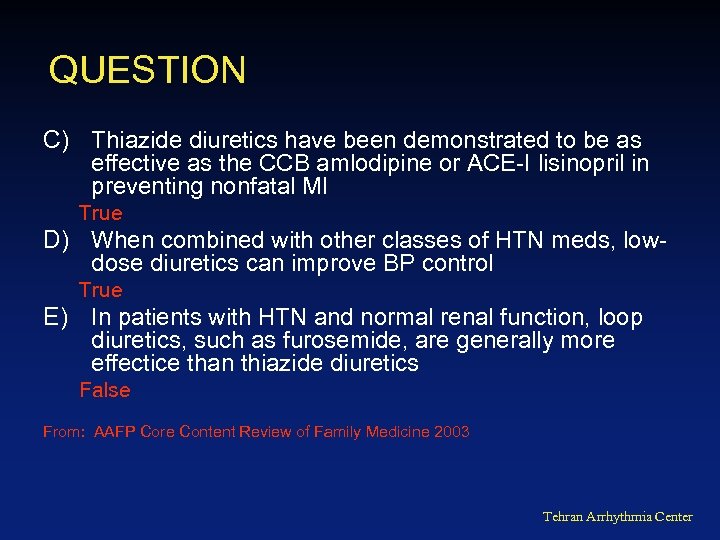
QUESTION C) Thiazide diuretics have been demonstrated to be as effective as the CCB amlodipine or ACE-I lisinopril in preventing nonfatal MI True D) When combined with other classes of HTN meds, lowdose diuretics can improve BP control True E) In patients with HTN and normal renal function, loop diuretics, such as furosemide, are generally more effectice than thiazide diuretics False From: AAFP Core Content Review of Family Medicine 2003 Tehran Arrhythmia Center
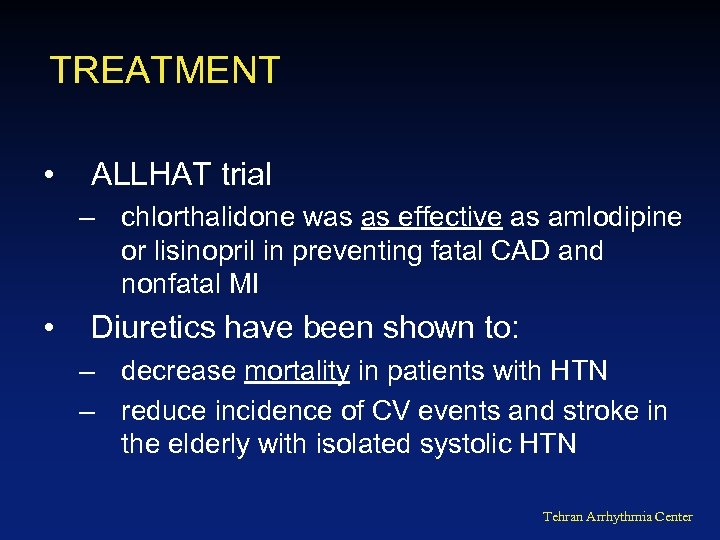
TREATMENT • ALLHAT trial – chlorthalidone was as effective as amlodipine or lisinopril in preventing fatal CAD and nonfatal MI • Diuretics have been shown to: – decrease mortality in patients with HTN – reduce incidence of CV events and stroke in the elderly with isolated systolic HTN Tehran Arrhythmia Center
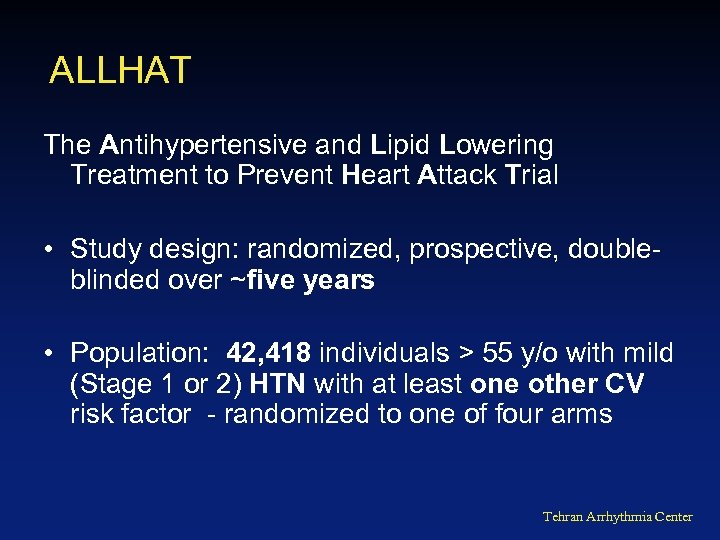
ALLHAT The Antihypertensive and Lipid Lowering Treatment to Prevent Heart Attack Trial • Study design: randomized, prospective, doubleblinded over ~five years • Population: 42, 418 individuals > 55 y/o with mild (Stage 1 or 2) HTN with at least one other CV risk factor - randomized to one of four arms Tehran Arrhythmia Center
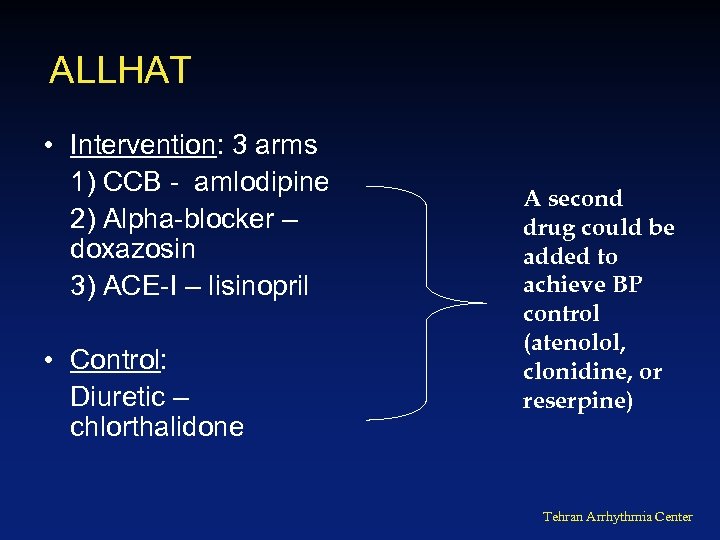
ALLHAT • Intervention: 3 arms 1) CCB - amlodipine 2) Alpha-blocker – doxazosin 3) ACE-I – lisinopril • Control: Diuretic – chlorthalidone A second drug could be added to achieve BP control (atenolol, clonidine, or reserpine) Tehran Arrhythmia Center

ALLHAT • Outcomes measured: – Primary outcomes: • fatal coronary heart disease • nonfatal MI No difference between the drug groups Simple message: treated patients do better Tehran Arrhythmia Center
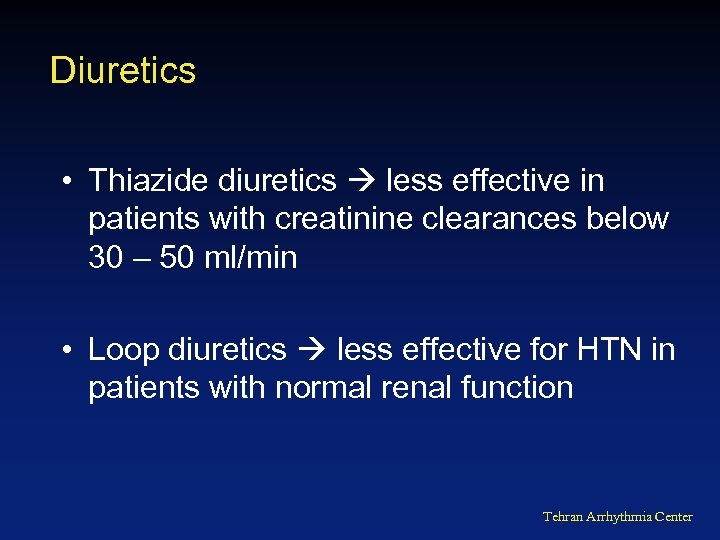
Diuretics • Thiazide diuretics less effective in patients with creatinine clearances below 30 – 50 ml/min • Loop diuretics less effective for HTN in patients with normal renal function Tehran Arrhythmia Center
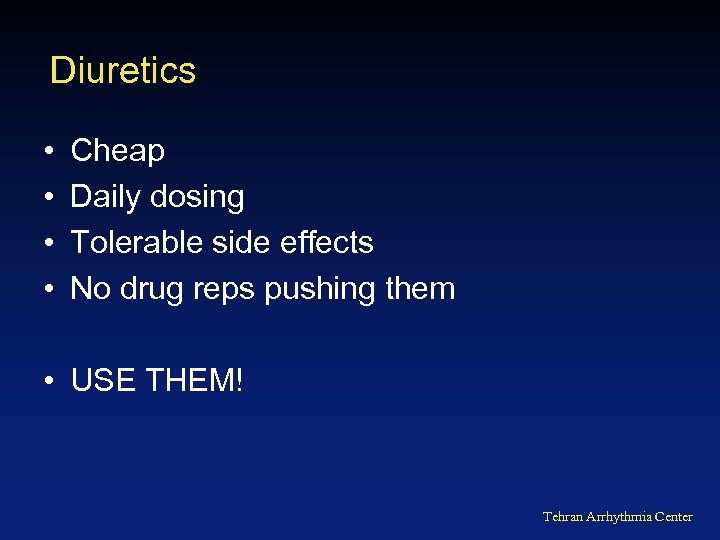
Diuretics • • Cheap Daily dosing Tolerable side effects No drug reps pushing them • USE THEM! Tehran Arrhythmia Center
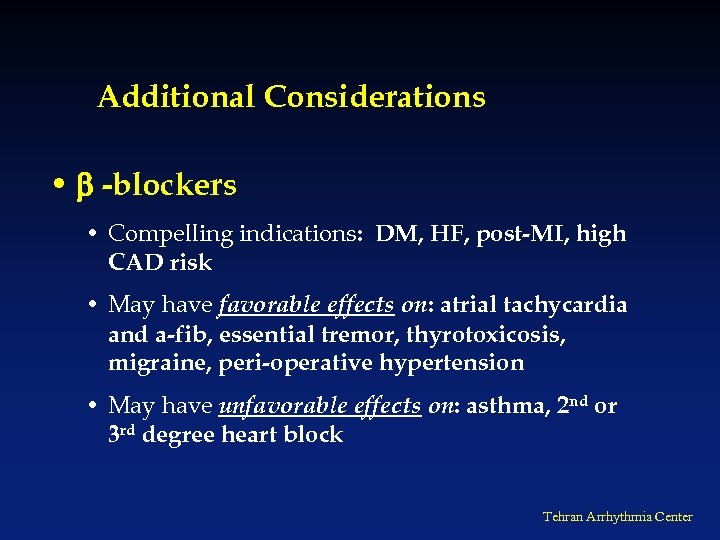
Additional Considerations • -blockers • Compelling indications: DM, HF, post-MI, high CAD risk • May have favorable effects on: atrial tachycardia and a-fib, essential tremor, thyrotoxicosis, migraine, peri-operative hypertension • May have unfavorable effects on: asthma, 2 nd or 3 rd degree heart block Tehran Arrhythmia Center
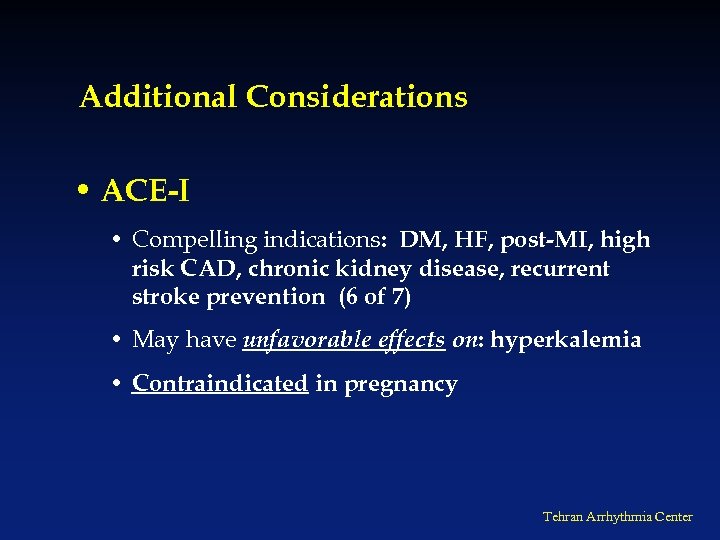
Additional Considerations • ACE-I • Compelling indications: DM, HF, post-MI, high risk CAD, chronic kidney disease, recurrent stroke prevention (6 of 7) • May have unfavorable effects on: hyperkalemia • Contraindicated in pregnancy Tehran Arrhythmia Center
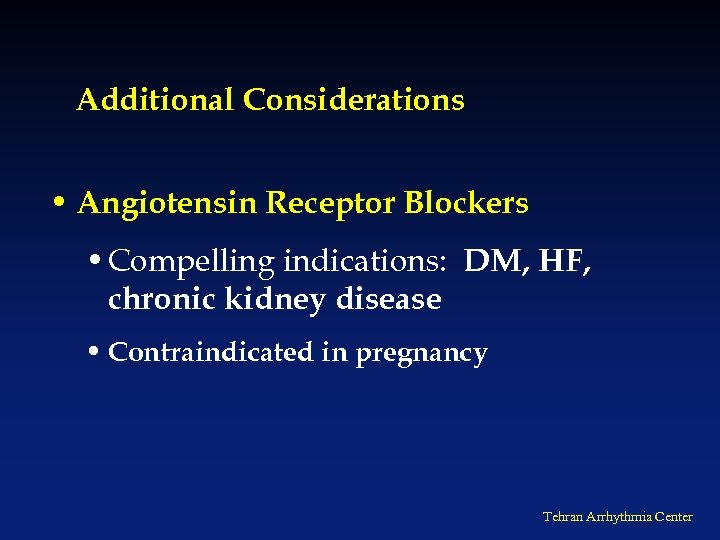
Additional Considerations • Angiotensin Receptor Blockers • Compelling indications: DM, HF, chronic kidney disease • Contraindicated in pregnancy Tehran Arrhythmia Center
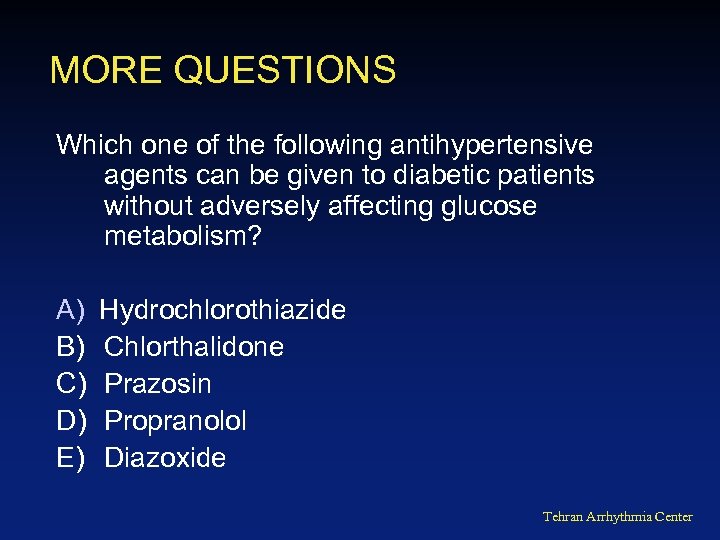
MORE QUESTIONS Which one of the following antihypertensive agents can be given to diabetic patients without adversely affecting glucose metabolism? A) Hydrochlorothiazide B) Chlorthalidone C) Prazosin D) Propranolol E) Diazoxide Tehran Arrhythmia Center
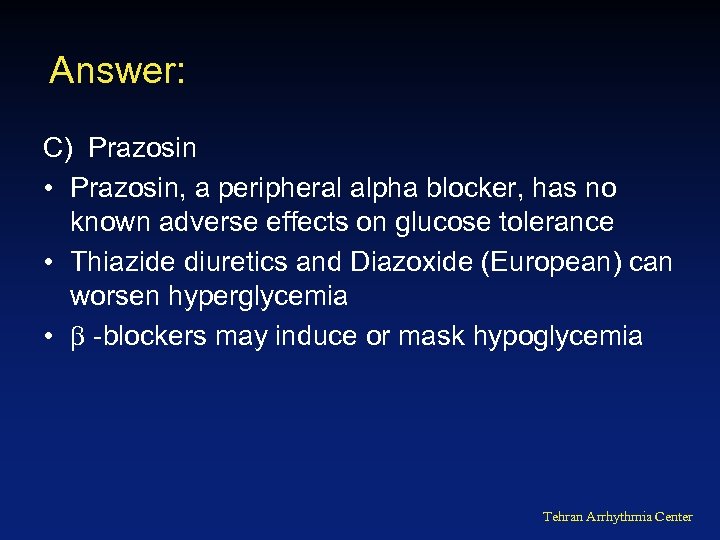
Answer: C) Prazosin • Prazosin, a peripheral alpha blocker, has no known adverse effects on glucose tolerance • Thiazide diuretics and Diazoxide (European) can worsen hyperglycemia • -blockers may induce or mask hypoglycemia Tehran Arrhythmia Center

MORE QUESTIONS A 50 y/o man with elevated cholesterol requires medication for HTN. Which one of the following can adversely affect the lipid profile? A) B) C) D) ACE inhibitors Calcium channel blockers Alpha blockers -blockers Tehran Arrhythmia Center
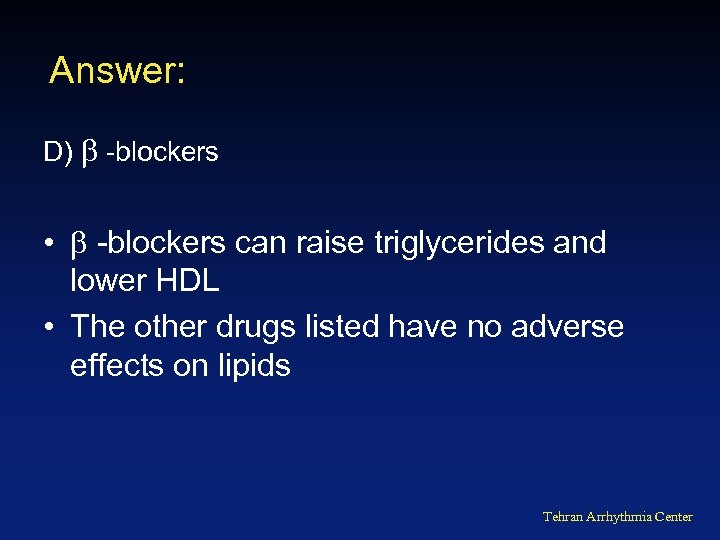
Answer: D) -blockers • -blockers can raise triglycerides and lower HDL • The other drugs listed have no adverse effects on lipids Tehran Arrhythmia Center
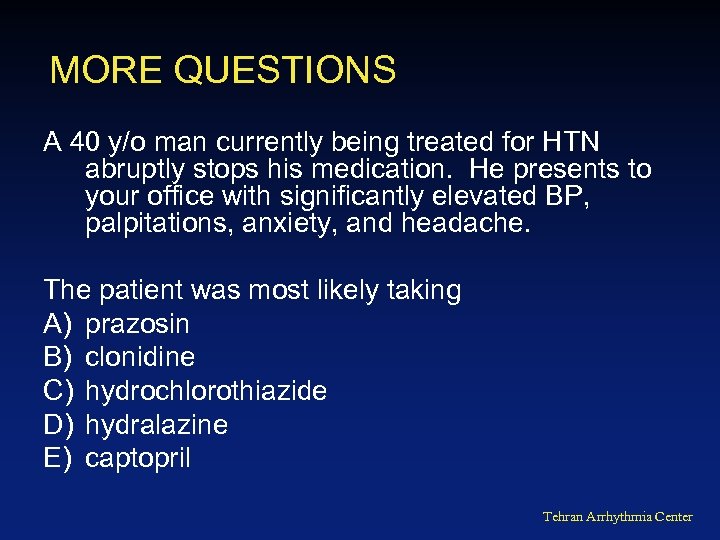
MORE QUESTIONS A 40 y/o man currently being treated for HTN abruptly stops his medication. He presents to your office with significantly elevated BP, palpitations, anxiety, and headache. The patient was most likely taking A) prazosin B) clonidine C) hydrochlorothiazide D) hydralazine E) captopril Tehran Arrhythmia Center
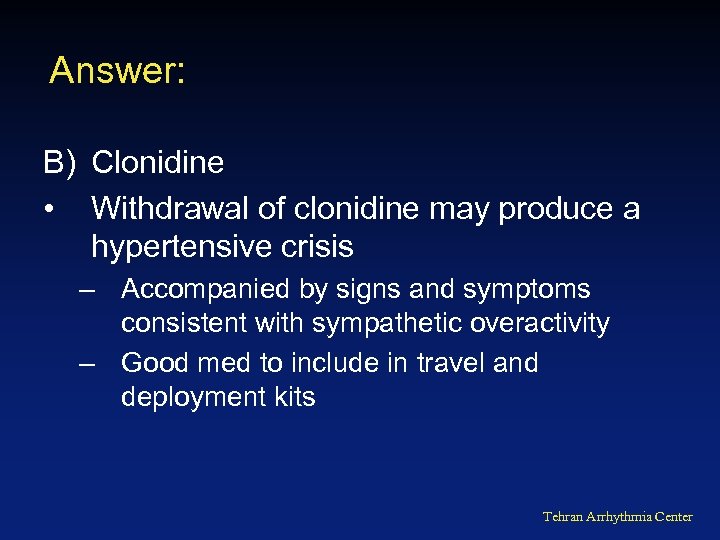
Answer: B) Clonidine • Withdrawal of clonidine may produce a hypertensive crisis – Accompanied by signs and symptoms consistent with sympathetic overactivity – Good med to include in travel and deployment kits Tehran Arrhythmia Center
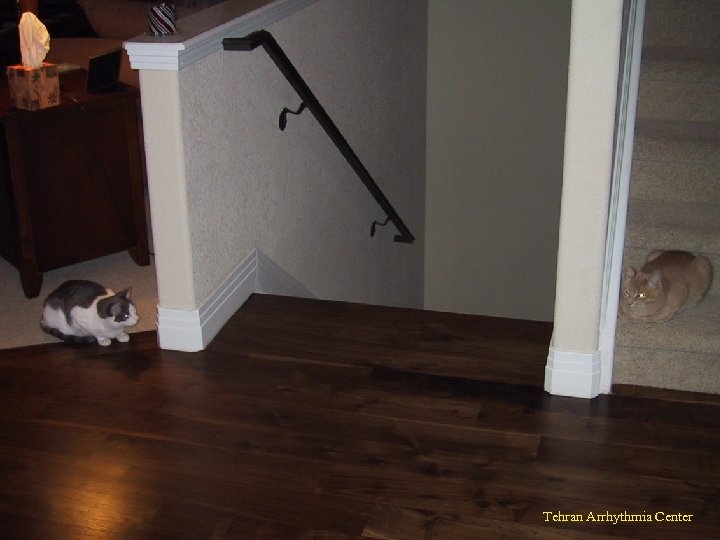
Tehran Arrhythmia Center
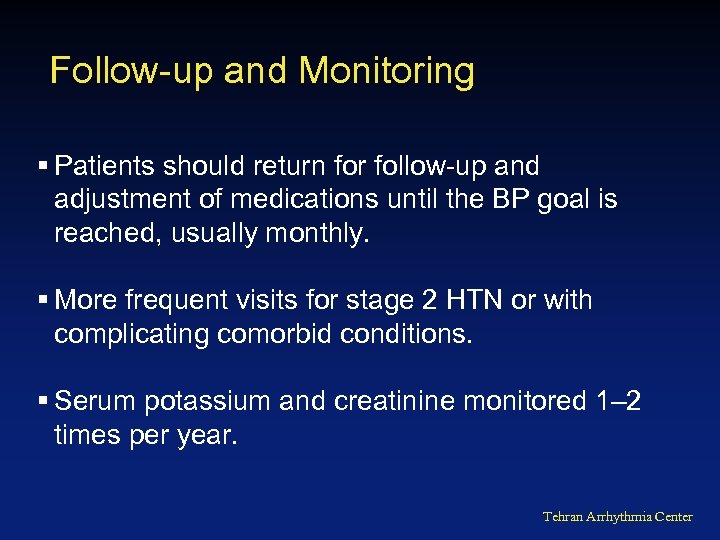
Follow-up and Monitoring § Patients should return for follow-up and adjustment of medications until the BP goal is reached, usually monthly. § More frequent visits for stage 2 HTN or with complicating comorbid conditions. § Serum potassium and creatinine monitored 1– 2 times per year. Tehran Arrhythmia Center
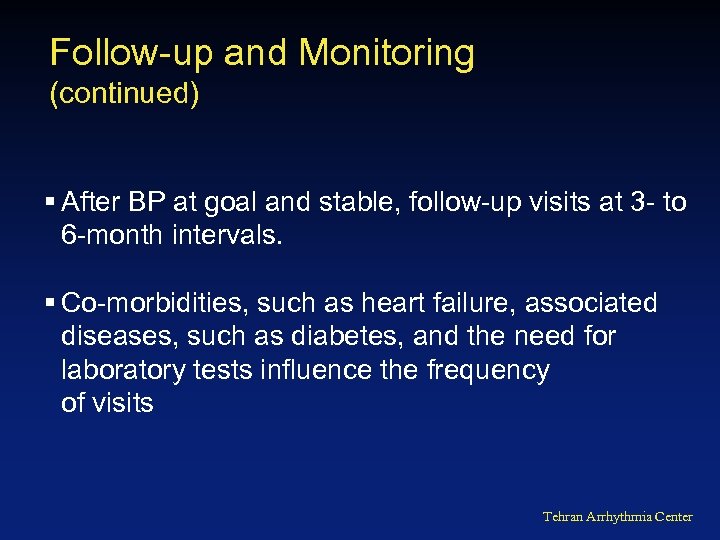
Follow-up and Monitoring (continued) § After BP at goal and stable, follow-up visits at 3 - to 6 -month intervals. § Co-morbidities, such as heart failure, associated diseases, such as diabetes, and the need for laboratory tests influence the frequency of visits Tehran Arrhythmia Center
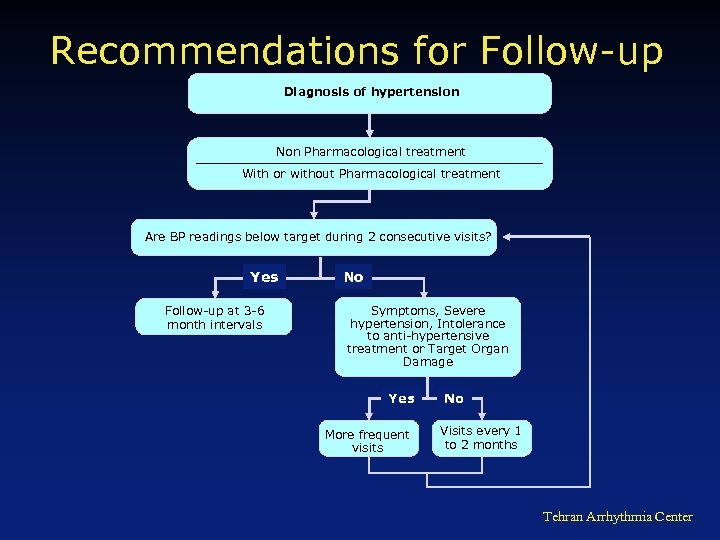
Recommendations for Follow-up Diagnosis of hypertension Non Pharmacological treatment With or without Pharmacological treatment Are BP readings below target during 2 consecutive visits? Yes Follow-up at 3 -6 month intervals No Symptoms, Severe hypertension, Intolerance to anti-hypertensive treatment or Target Organ Damage Yes More frequent visits No Visits every 1 to 2 months Tehran Arrhythmia Center
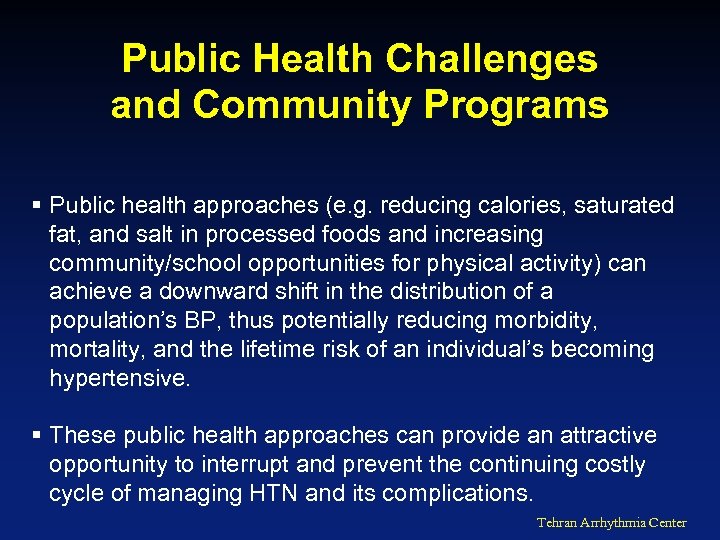
Public Health Challenges and Community Programs § Public health approaches (e. g. reducing calories, saturated fat, and salt in processed foods and increasing community/school opportunities for physical activity) can achieve a downward shift in the distribution of a population’s BP, thus potentially reducing morbidity, mortality, and the lifetime risk of an individual’s becoming hypertensive. § These public health approaches can provide an attractive opportunity to interrupt and prevent the continuing costly cycle of managing HTN and its complications. Tehran Arrhythmia Center
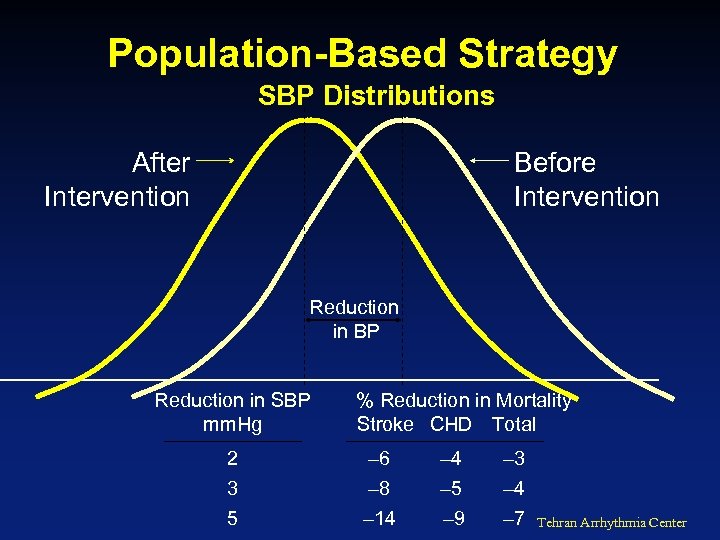
Population-Based Strategy SBP Distributions After Intervention Before Intervention Reduction in BP Reduction in SBP mm. Hg 2 3 5 % Reduction in Mortality Stroke CHD Total – 6 – 4 – 3 – 8 – 14 – 5 – 9 – 4 – 7 Tehran Arrhythmia Center

Go Air Force Tehran Arrhythmia Center
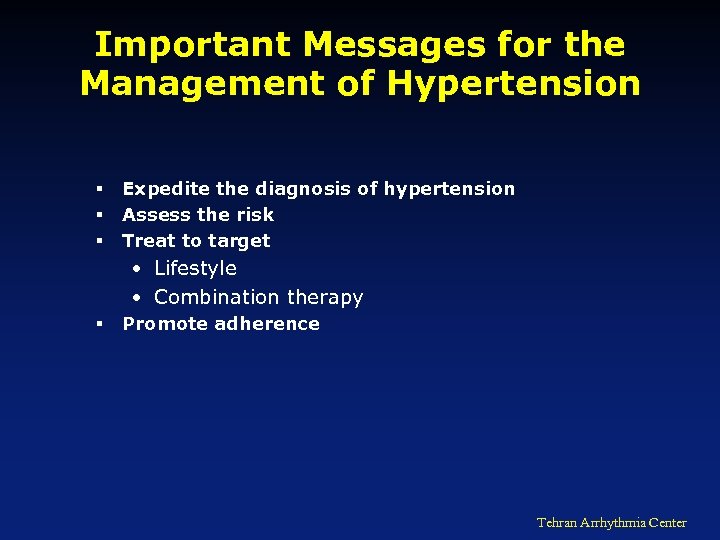
Important Messages for the Management of Hypertension § § § Expedite the diagnosis of hypertension Assess the risk Treat to target • Lifestyle • Combination therapy § Promote adherence Tehran Arrhythmia Center
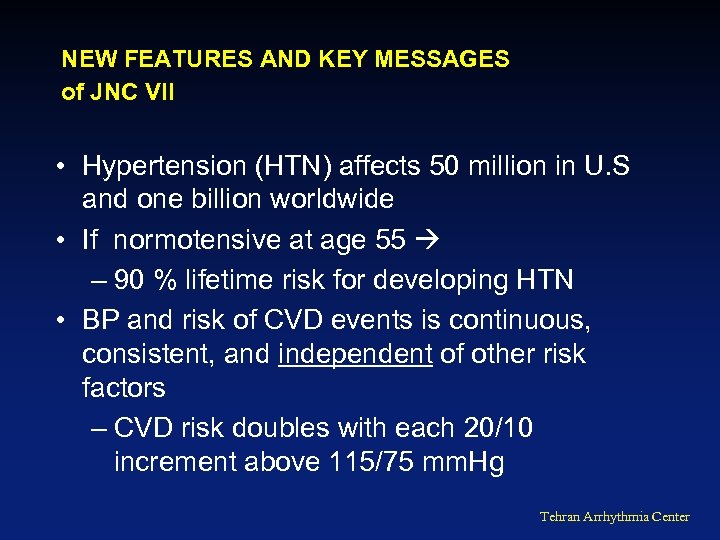
NEW FEATURES AND KEY MESSAGES of JNC VII • Hypertension (HTN) affects 50 million in U. S and one billion worldwide • If normotensive at age 55 – 90 % lifetime risk for developing HTN • BP and risk of CVD events is continuous, consistent, and independent of other risk factors – CVD risk doubles with each 20/10 increment above 115/75 mm. Hg Tehran Arrhythmia Center
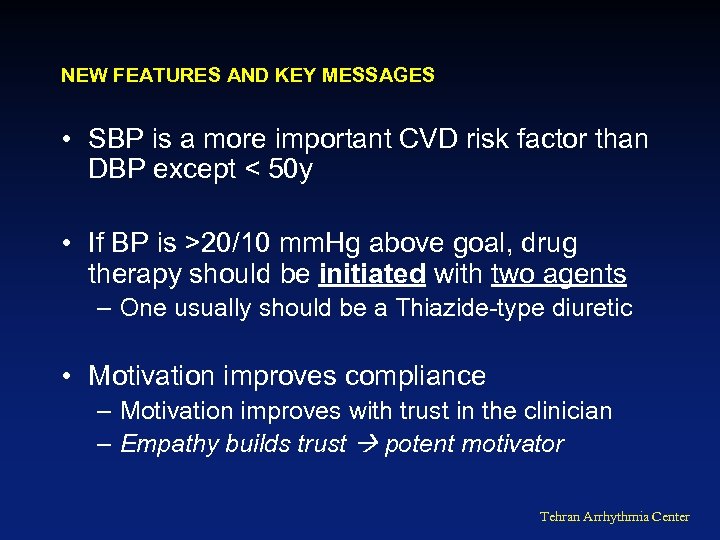
NEW FEATURES AND KEY MESSAGES • SBP is a more important CVD risk factor than DBP except < 50 y • If BP is >20/10 mm. Hg above goal, drug therapy should be initiated with two agents – One usually should be a Thiazide-type diuretic • Motivation improves compliance – Motivation improves with trust in the clinician – Empathy builds trust potent motivator Tehran Arrhythmia Center
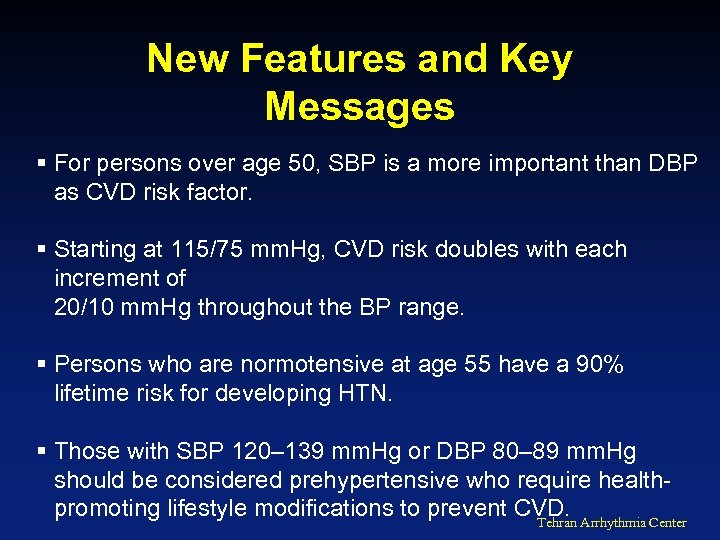
New Features and Key Messages § For persons over age 50, SBP is a more important than DBP as CVD risk factor. § Starting at 115/75 mm. Hg, CVD risk doubles with each increment of 20/10 mm. Hg throughout the BP range. § Persons who are normotensive at age 55 have a 90% lifetime risk for developing HTN. § Those with SBP 120– 139 mm. Hg or DBP 80– 89 mm. Hg should be considered prehypertensive who require healthpromoting lifestyle modifications to prevent CVD. Arrhythmia Center Tehran
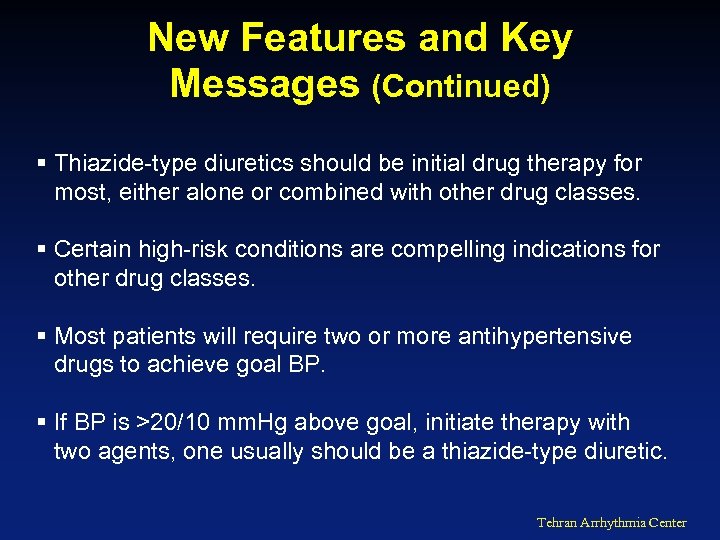
New Features and Key Messages (Continued) § Thiazide-type diuretics should be initial drug therapy for most, either alone or combined with other drug classes. § Certain high-risk conditions are compelling indications for other drug classes. § Most patients will require two or more antihypertensive drugs to achieve goal BP. § If BP is >20/10 mm. Hg above goal, initiate therapy with two agents, one usually should be a thiazide-type diuretic. Tehran Arrhythmia Center
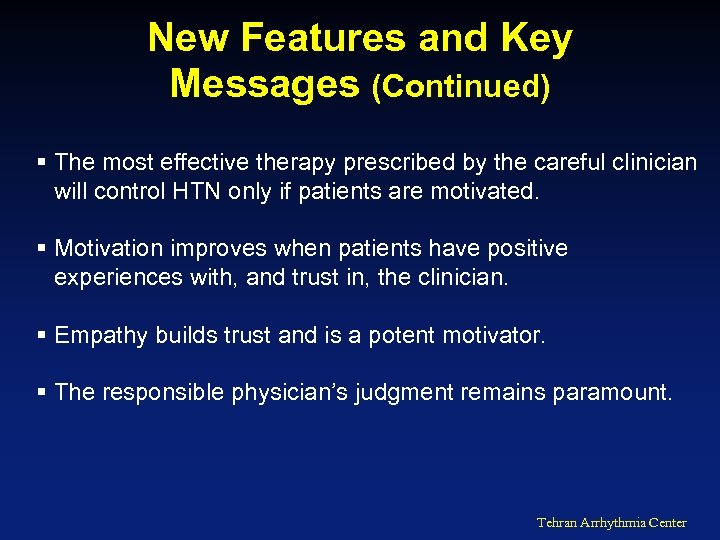
New Features and Key Messages (Continued) § The most effective therapy prescribed by the careful clinician will control HTN only if patients are motivated. § Motivation improves when patients have positive experiences with, and trust in, the clinician. § Empathy builds trust and is a potent motivator. § The responsible physician’s judgment remains paramount. Tehran Arrhythmia Center

Hypertensive Urgencies and Emergencies § Patients with marked BP elevations and acute TOD (e. g. , encephalopathy, myocardial infarction, unstable angina, pulmonary edema, eclampsia, stroke, head trauma, lifethreatening arterial bleeding, or aortic dissection) require hospitalization and parenteral drug therapy. § Patients with markedly elevated BP but without acute TOD usually do not require hospitalization, but should receive immediate combination oral antihypertensive therapy. Tehran Arrhythmia Center
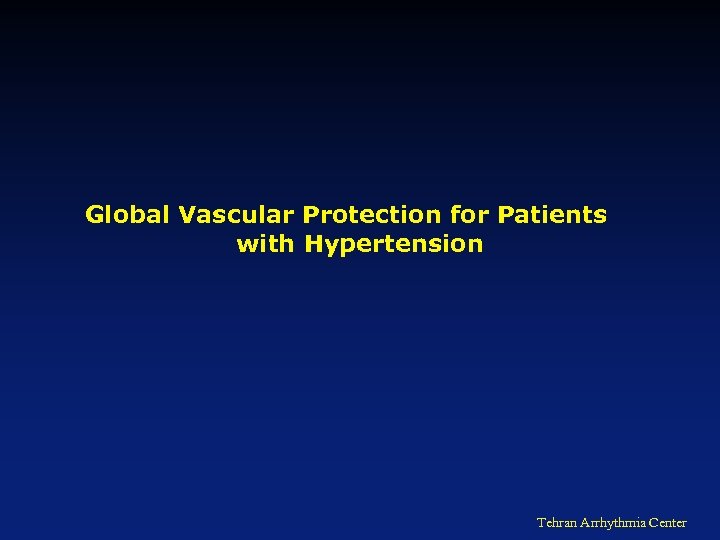
Global Vascular Protection for Patients with Hypertension Tehran Arrhythmia Center
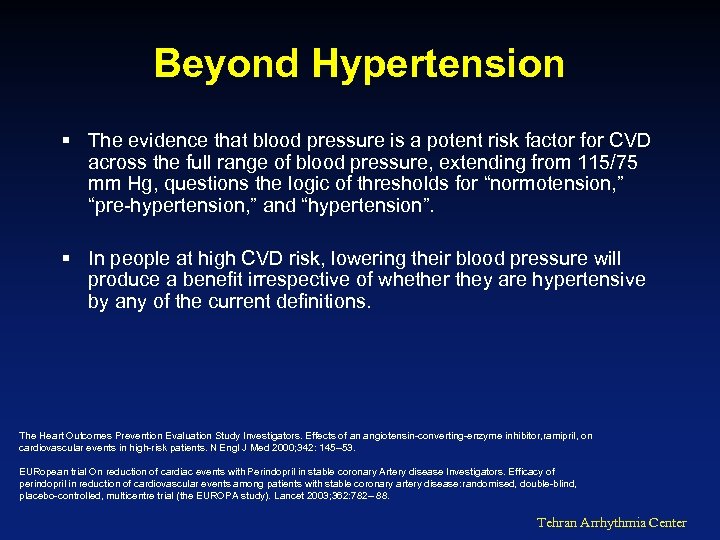
Beyond Hypertension § The evidence that blood pressure is a potent risk factor for CVD across the full range of blood pressure, extending from 115/75 mm Hg, questions the logic of thresholds for “normotension, ” “pre-hypertension, ” and “hypertension”. § In people at high CVD risk, lowering their blood pressure will produce a benefit irrespective of whether they are hypertensive by any of the current definitions. The Heart Outcomes Prevention Evaluation Study Investigators. Effects of an angiotensin-converting-enzyme inhibitor, amipril, on r cardiovascular events in high-risk patients. N Engl J Med 2000; 342: 145– 53. EURopean trial On reduction of cardiac events with Perindopril in stable coronary Artery disease Investigators. Efficacy of perindopril in reduction of cardiovascular events among patients with stable coronary artery disease: andomised, double-blind, r placebo-controlled, multicentre trial (the EUROPA study). Lancet 2003; 362: 782– 88. Tehran Arrhythmia Center
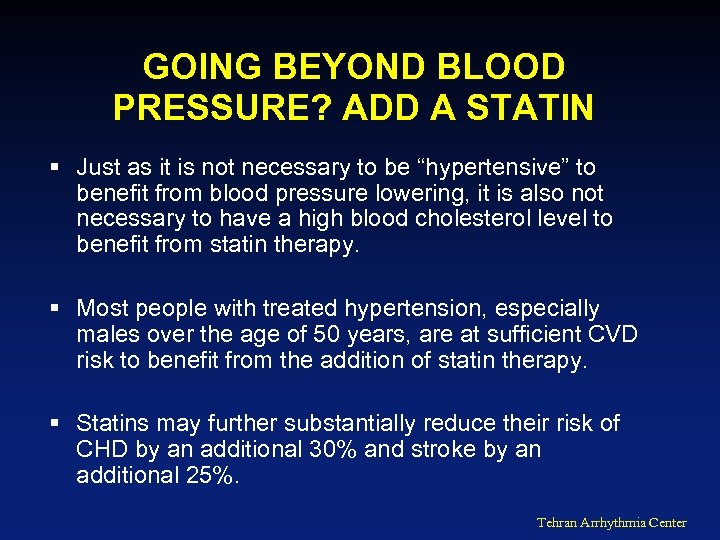
GOING BEYOND BLOOD PRESSURE? ADD A STATIN § Just as it is not necessary to be “hypertensive” to benefit from blood pressure lowering, it is also not necessary to have a high blood cholesterol level to benefit from statin therapy. § Most people with treated hypertension, especially males over the age of 50 years, are at sufficient CVD risk to benefit from the addition of statin therapy. § Statins may further substantially reduce their risk of CHD by an additional 30% and stroke by an additional 25%. Tehran Arrhythmia Center

Vascular Protection for Hypertensive Patients: Statins are specially recommended in high-risk hypertensive patients with established atherosclerotic disease or with at least 3 cardiovascular risks such as : • Male • 55 y or older • Smoking • Type 2 Diabetes • Total-C/HDL-C ratio of 6 or higher • Premature Family History of CV disease • Previous Stroke or TIA • LVH • ECG abnormalities • Microalbuminuria or Proteinuria • Peripheral Vascular Disease ASCOT-LLA Lancet 2003; 361: 1149 -58 Tehran Arrhythmia Center
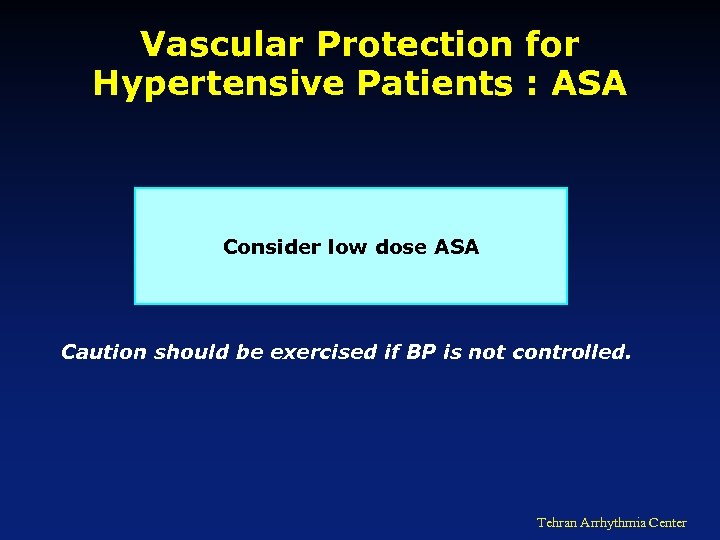
Vascular Protection for Hypertensive Patients : ASA Consider low dose ASA Caution should be exercised if BP is not controlled. Tehran Arrhythmia Center
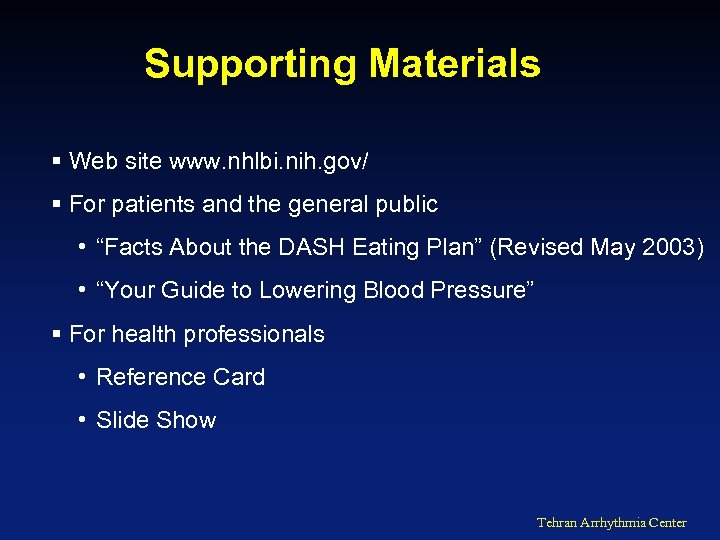
Supporting Materials § Web site www. nhlbi. nih. gov/ § For patients and the general public • “Facts About the DASH Eating Plan” (Revised May 2003) • “Your Guide to Lowering Blood Pressure” § For health professionals • Reference Card • Slide Show Tehran Arrhythmia Center
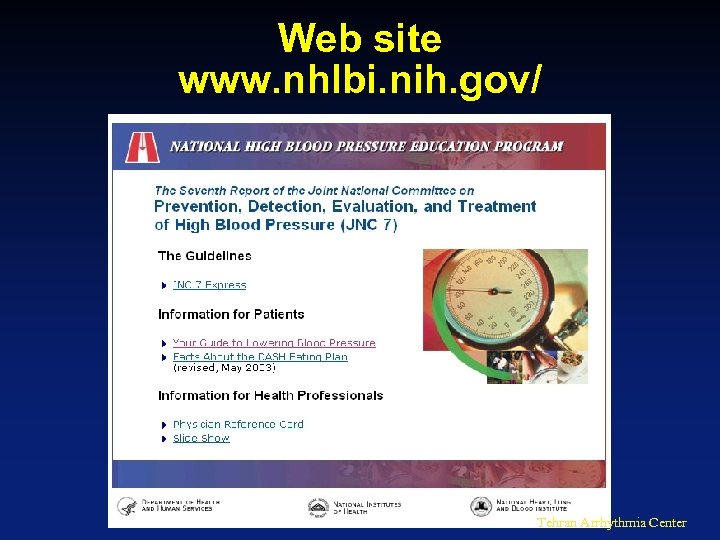
Web site www. nhlbi. nih. gov/ Tehran Arrhythmia Center
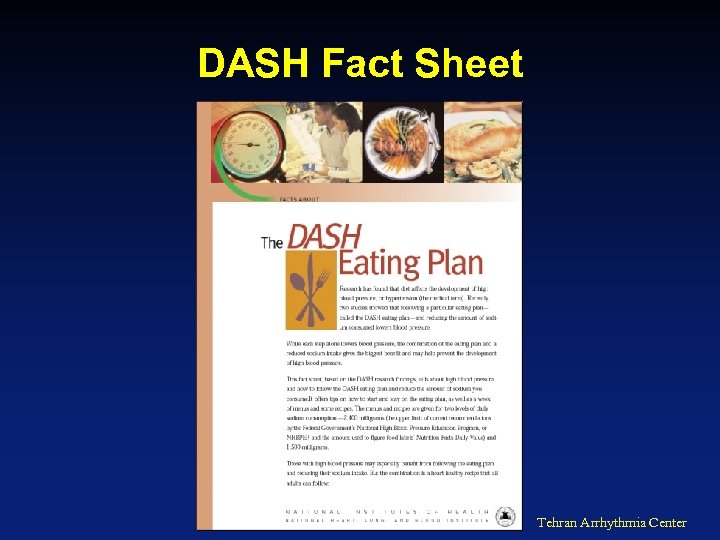
DASH Fact Sheet Tehran Arrhythmia Center
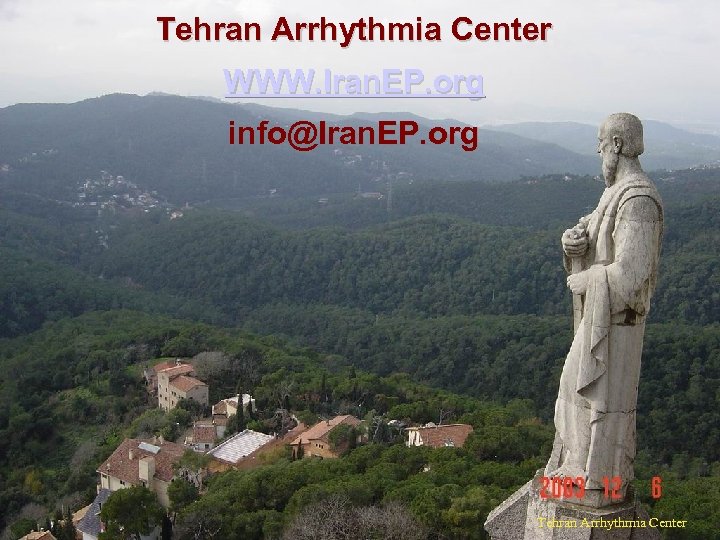
Tehran Arrhythmia Center WWW. Iran. EP. org info@Iran. EP. org Tehran Arrhythmia Center
c5a9ddccea609144e2912521a95cd97c.ppt